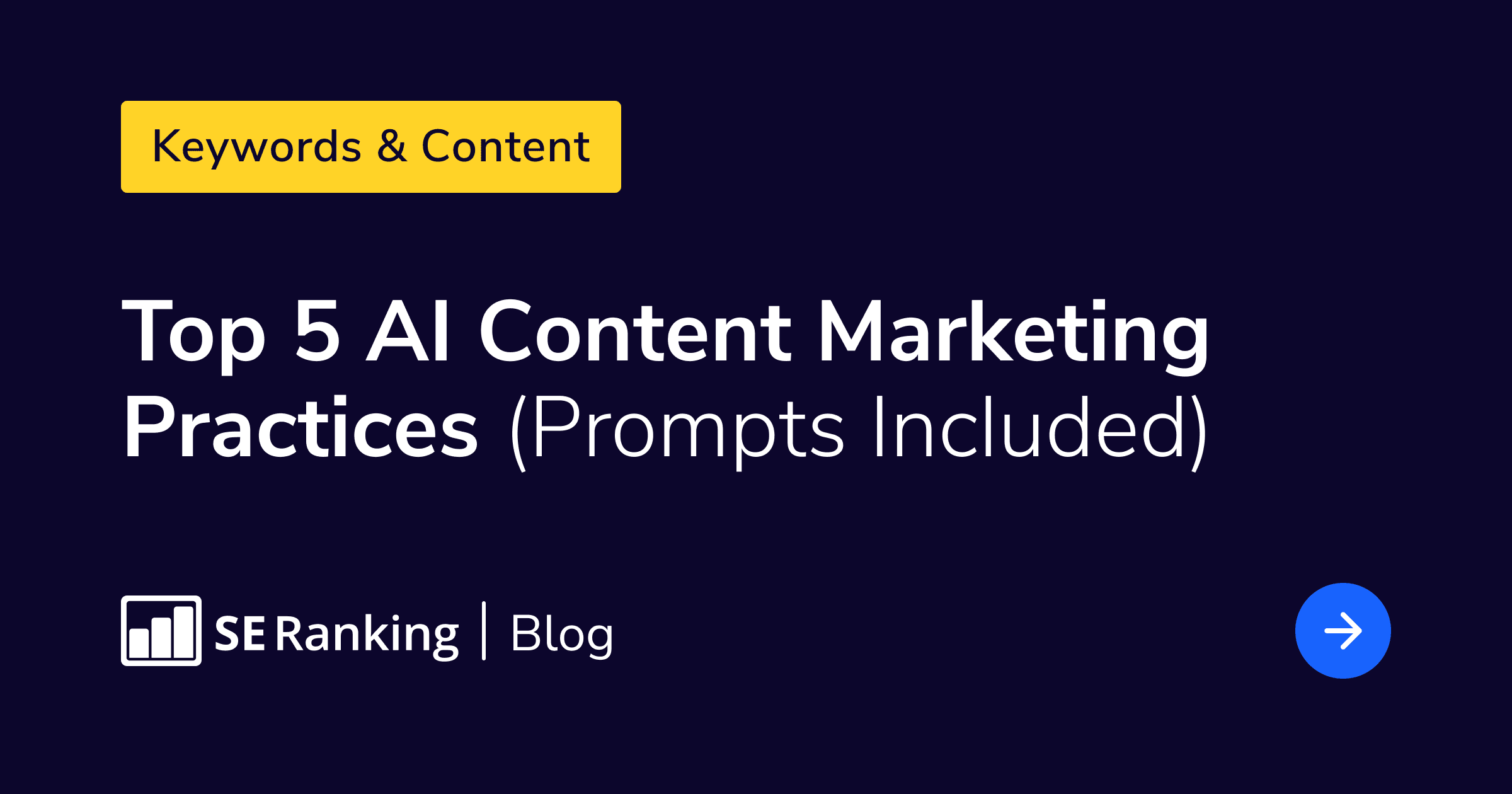Producing captivating content takes substantial effort. This includes audience research, brainstorming, outlining, drafts, SEO editing, and the list goes on!
But what if AI could help you streamline this process?
While AI tools can’t instantly produce perfect articles for your target audience, they can boost your content creation efficiency. Imagine a 20% productivity jump. This could open up more time for you to focus on other high-impact marketing activities (or to simply spend more time with your loved ones).
In this blog post, we’ll explore five powerful AI content marketing tactics with real-world examples. Each example will demonstrate how to use AI tools to get exceptional results and save ample time.
So, buckle up, and let’s begin!
Getting started with AI content marketing
Before jumping straight to outlining practical steps for AI-powered content creation, let’s first look at how to “prepare” AI tools for this process.
Preparing, in this case, means training the tool to understand both your target audience and content creation style. This steers it away from producing generic responses and towards better ones tailored to your ICP. You can also train it to write in your brand’s tone of voice.
Create an AI-powered persona
Foundational to any effective content strategy is the ability to understand your audience.
If you already have a detailed description of your ICP, that’s great! Provide this to your AI tool and ask it to generate future content pieces with this target audience in mind.
If you don’t have one, you can leverage AI’s help to identify a detailed buyer persona. Here’s how:
1. Write down the common attributes of your ideal customer.
While it’s important to identify details like the age, gender, and location of your target audience, building a strong ICP requires more in-depth research. In particular, when providing AI with a detailed prompt outlining your target audience, mention aspects like job title, company size, business category, geography, company purpose, and business challenges. It also helps to ask the AI to outline your audience’s goals, pain points, and decision criteria when selecting a social media marketing company.
Let’s say you are running a company offering social media services. Here’s an example of a useful ChatGPT prompt for this purpose:
Build a persona for a Marketing Director of a $10M non-profit in the midwest US with a mission to provide better access to healthcare resources in underserved communities. This person’s goal is to create more effective fundraising campaigns through digital marketing to promote their events. Include specific details about goals, pain points, and criteria for selecting a social media marketing company.
The screenshot below displays the initial response generated by ChatGPT. Is it perfect to go? Absolutely not! Did we expect it to be perfect with just a single prompt? Once again, no!
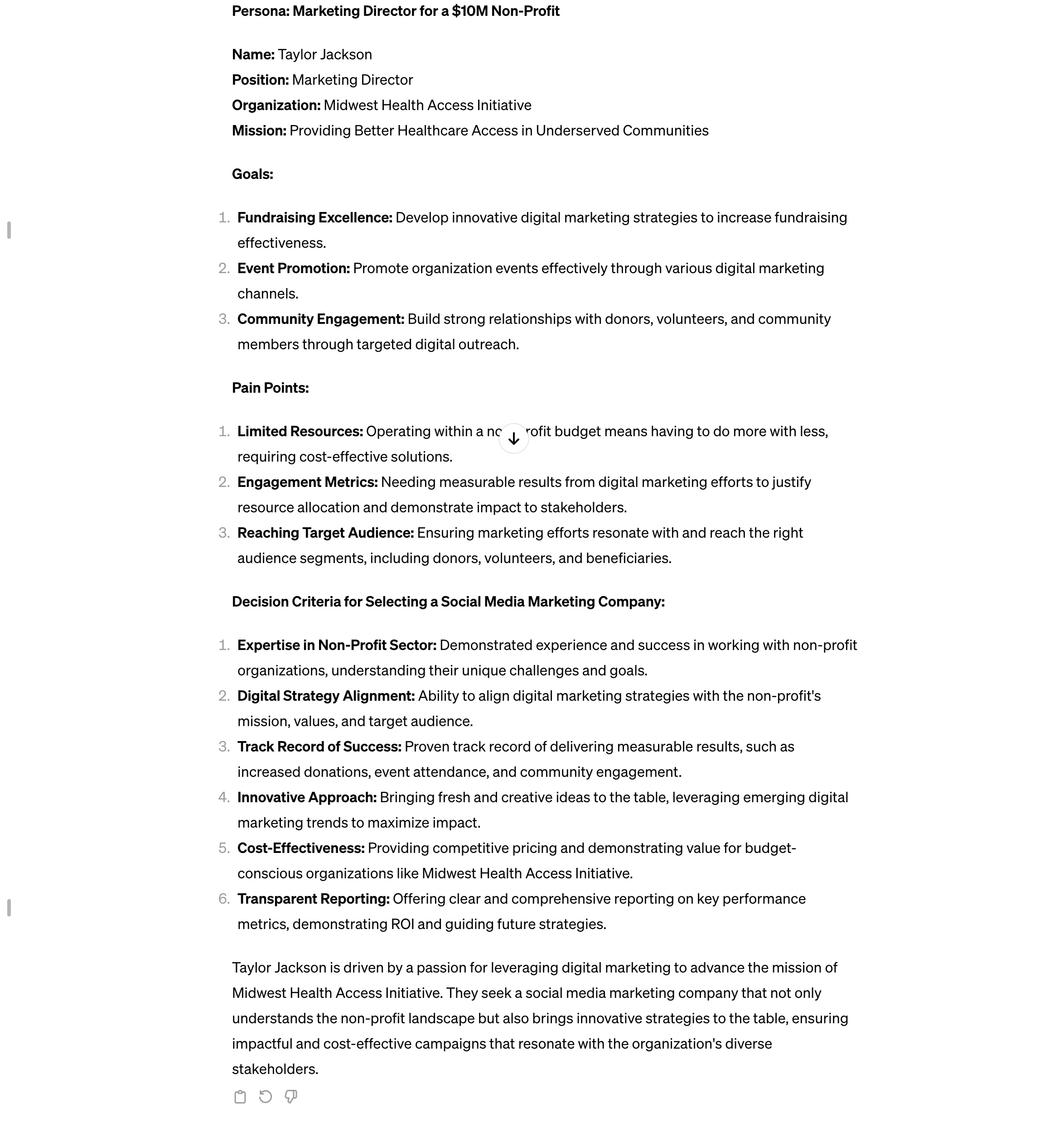
Now that the AI has helped us craft a great starting point for our ICP, it’s time to take the next essential step; editing and refining.
2. Improve the quality of the initial AI-generated response about your ICP.
First, add more data-backed ICP insights and remove any irrelevant data created by the tool. Next, interact with the tool as if it were your target audience. For instance, here’s a list of relevant questions to ask, specifically to collect deeper insights:
- What information would help you be more effective at your job?
- What social media posts are you most likely to click on?
- What information are you most likely to search for?
- Which research studies would support your current initiatives?
- What do you hate the most about finding a new marketing agency?
You can adjust this list of questions according to your needs and interests. The main idea is to gain as much valuable information on your target audience as possible. Don’t be afraid to explore areas where it may be uncomfortable to ask real people directly. In the end, it’s a fictional representation of your ICP.
Train AI to be like you
Having a well-defined ICP is great and all. But for ChatGPT to generate a solid content draft, it also needs to understand your tone of voice and writing style. Fortunately, you can train it to do just that.
Start by compiling a list of your existing articles (10 articles is enough) and ask the tool to evaluate them and identify common writing tactics.
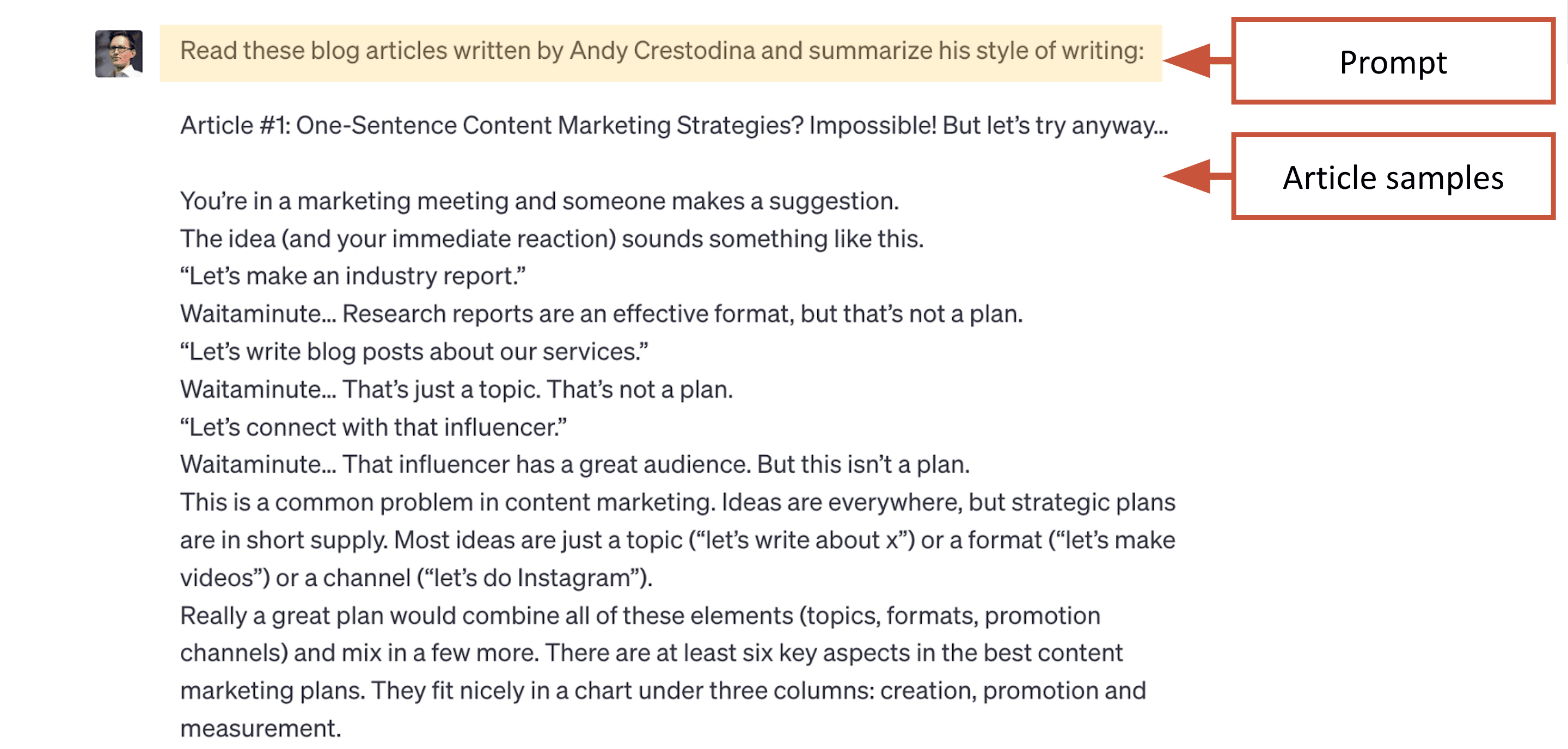
Note: For your convenience, you can summarize all your articles in a separate document and then integrate them into your prompt.
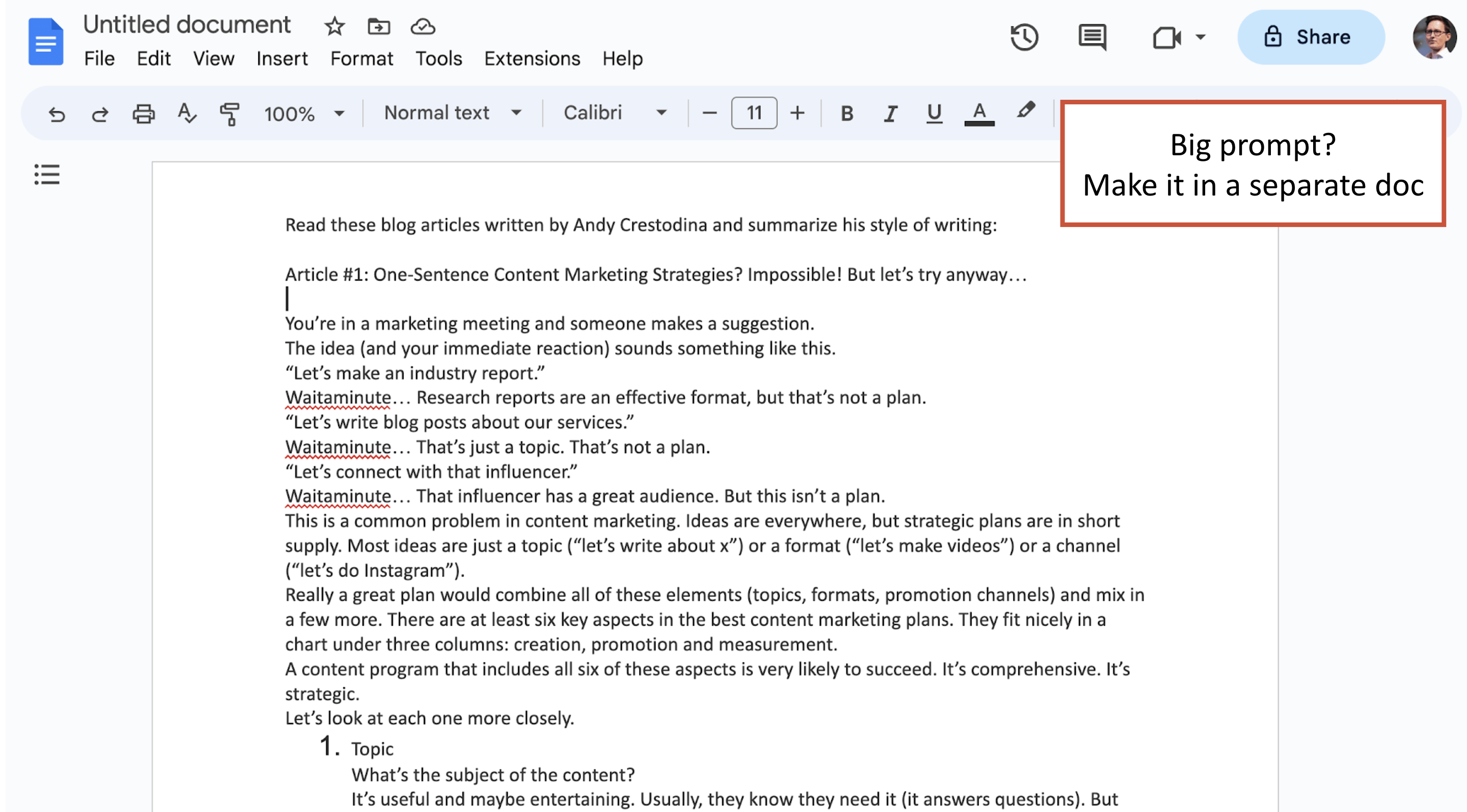
Here’s the breakdown of my writing style according to ChatGPT:
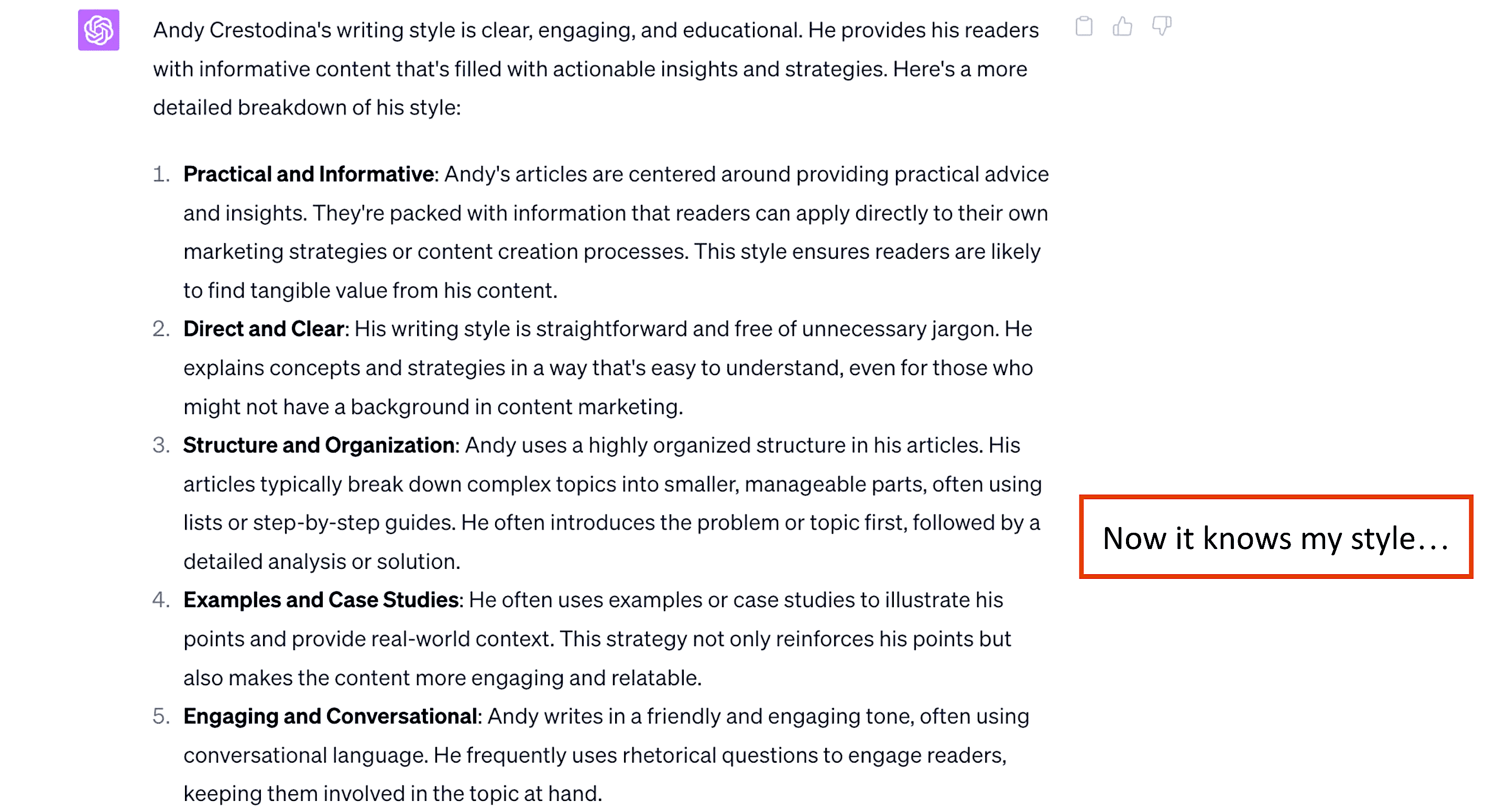
Excellent! The tool has captured my writing style. Now we can use it for content creation.
Since the preparation stage for content creation using AI assistance is done, let’s move on to the meat and potatoes of this article.
Best ways to use AI in content marketing
After countless hours and thousands of prompts, I believe I’ve managed to understand how to drive as much quality out of AI as possible. Here are some effective (and surprisingly simple) ways to use AI.
1. Generate content ideas
To begin with, let’s see what AI generates for a generic prompt like: “Write 10 article ideas for a company that does marketing for non-profits”:
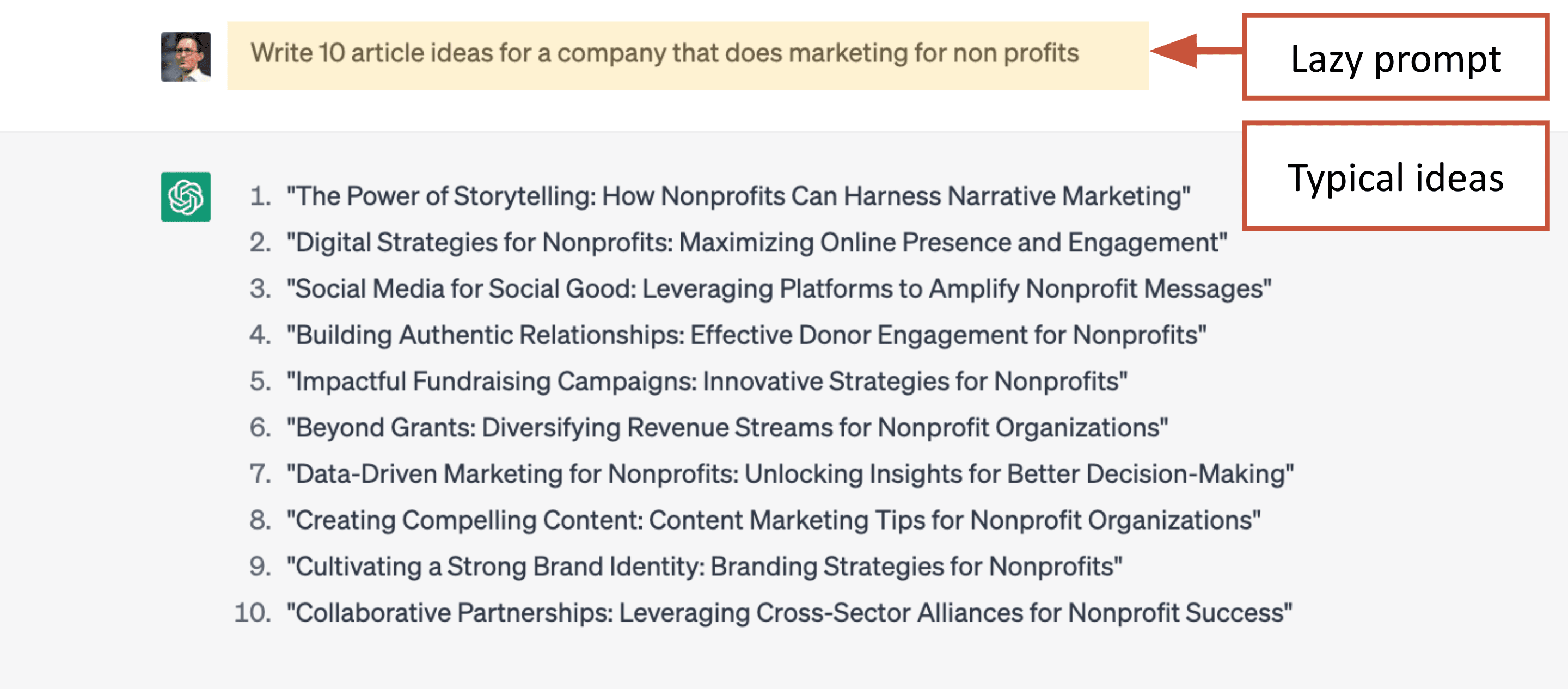
Pretty average response with no unique value, right?
In fact, marketers sometimes joke that AI stands for “average information.” While there is truth to this statement, a trained AI can do wonders.
Initial AI responses often reflect the average of all crawlable web content. Training enhances the AI’s abilities to provide more insightful and valuable responses.
To unlock AI’s potential, supply it with focused data and set clear goals for it.
For instance, start by asking ChatGPT to pretend as if it is your ICP. Ask it about the main marketing-related concerns it faces. It may return a list of valuable insights into these challenges.
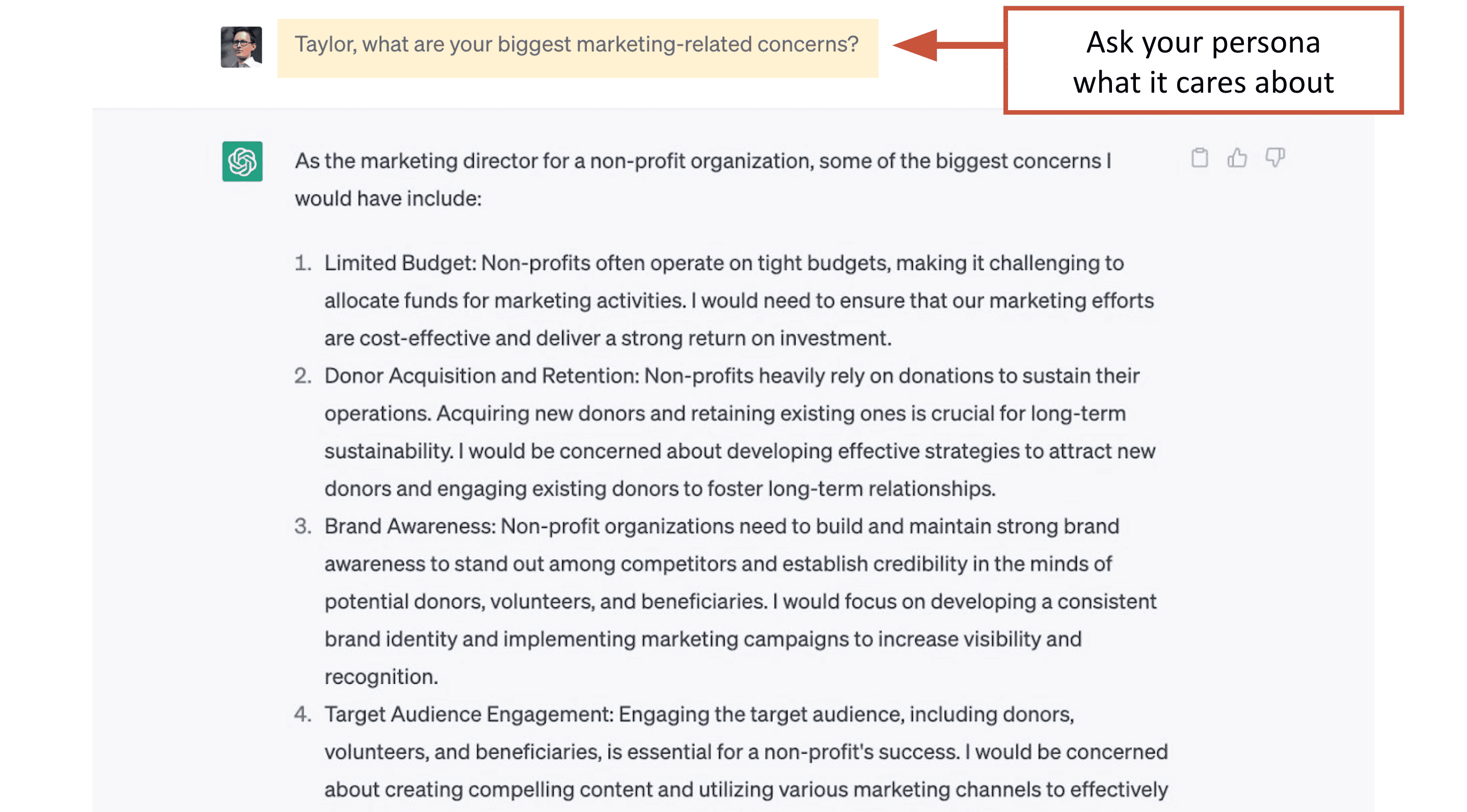
The next thing you should do is ask the tool to create a list of content topics based on a specific concern from this list.
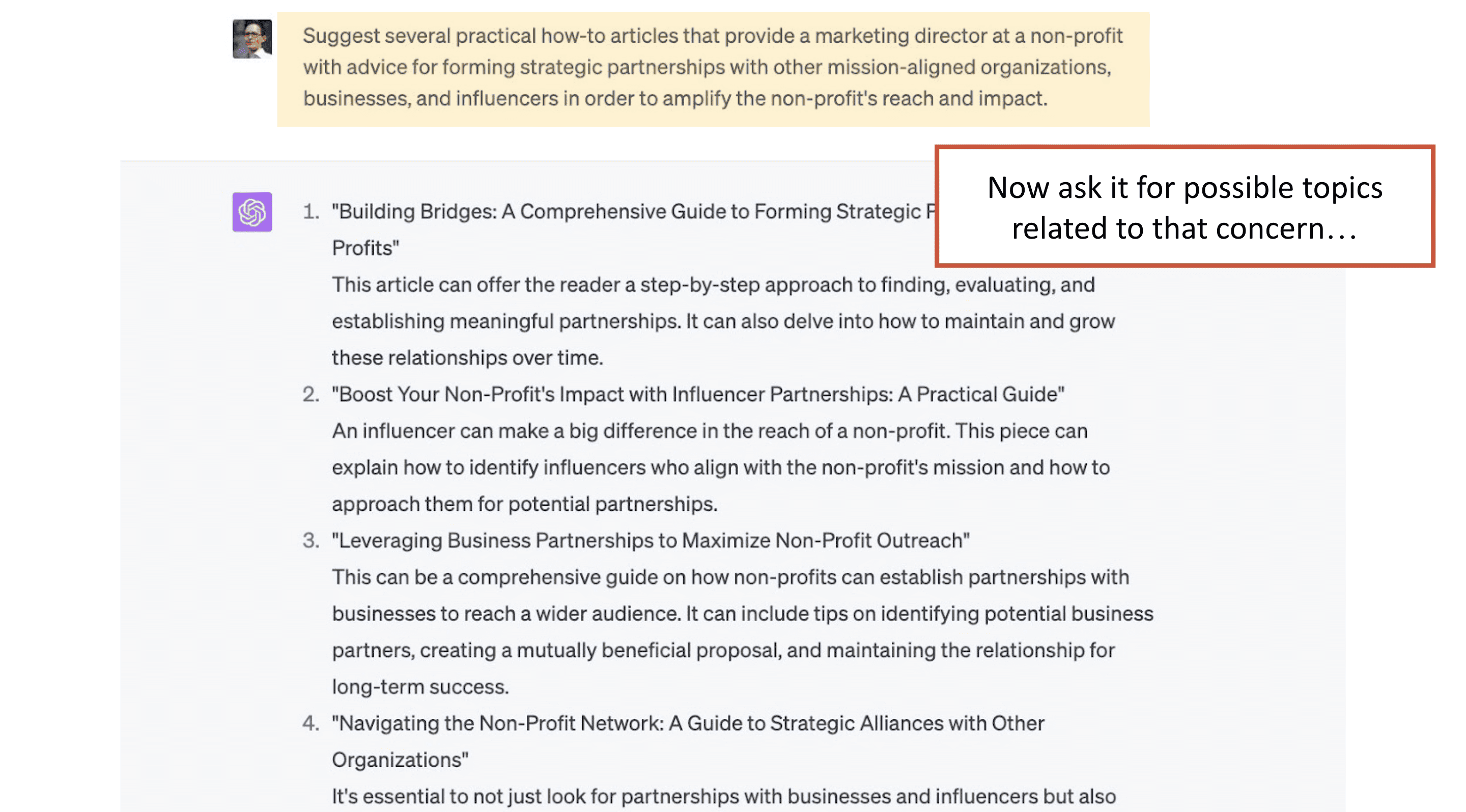
Sifting through this list will help you find a good topic idea around this concern.
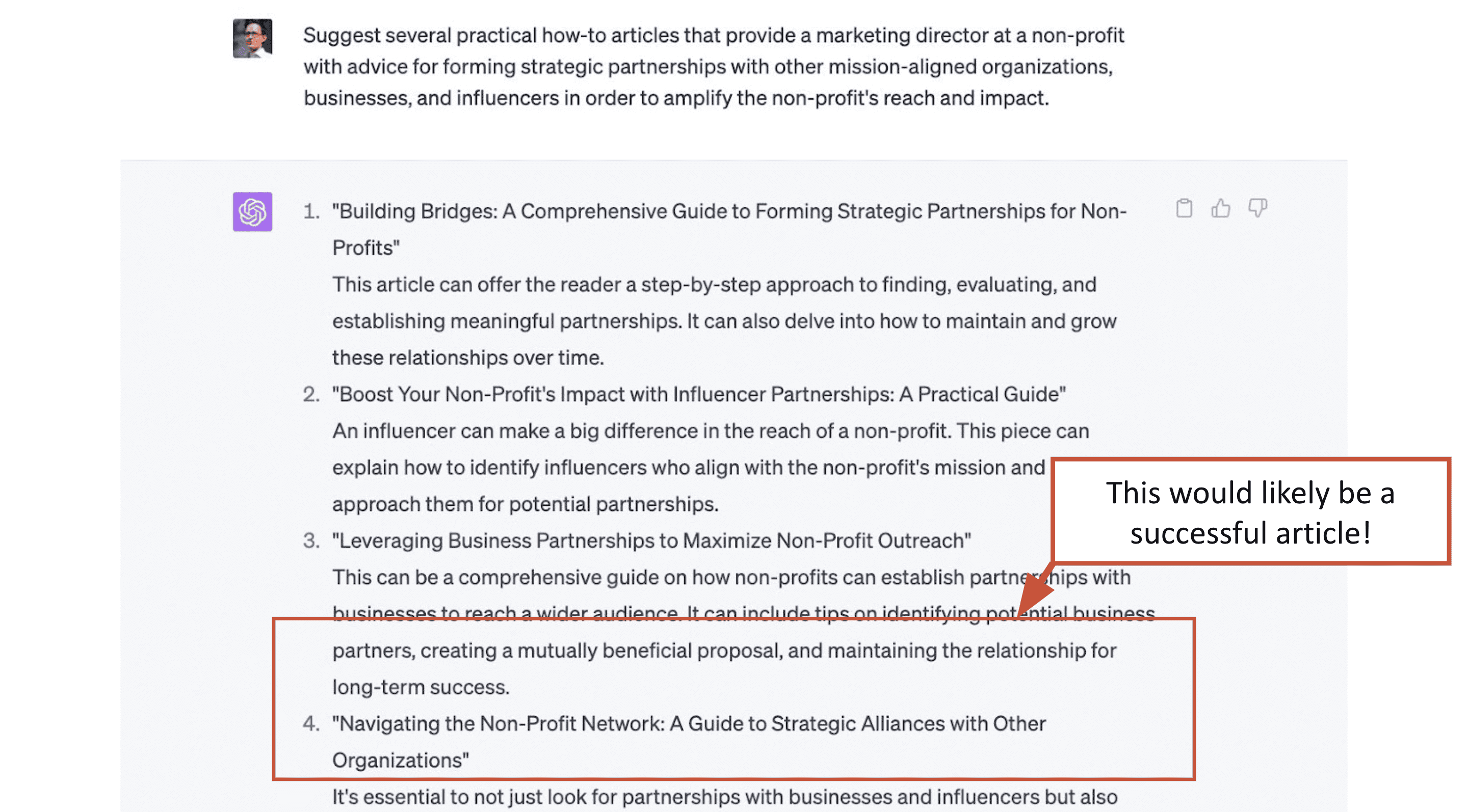
2. Write the outline
Now that you have a topic idea for your new article, let’s request a topic outline from ChatGPT in the persona chat. Don’t forget to communicate the goal of this blog post to the tool.
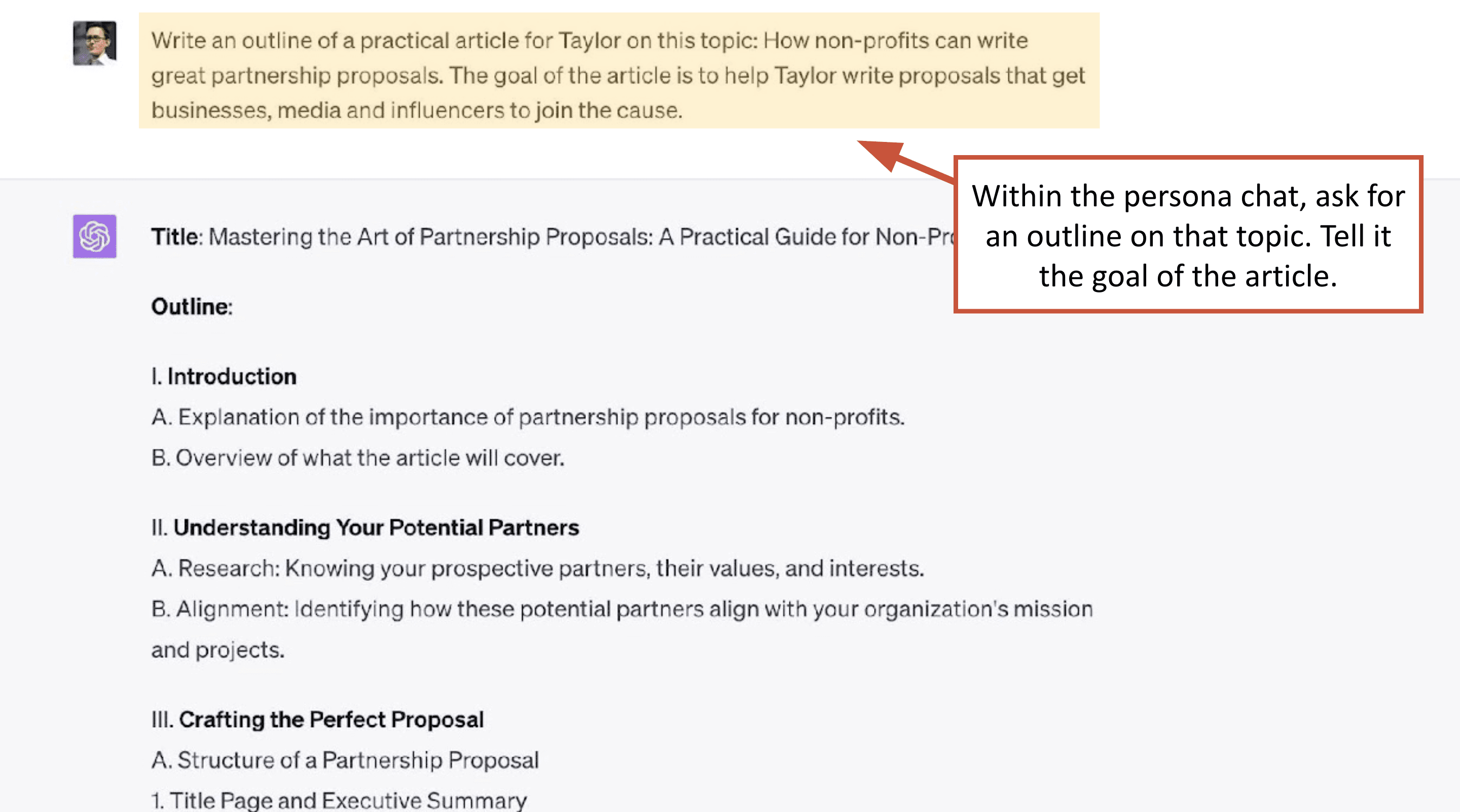
Here is what the tool generated in response to our request:
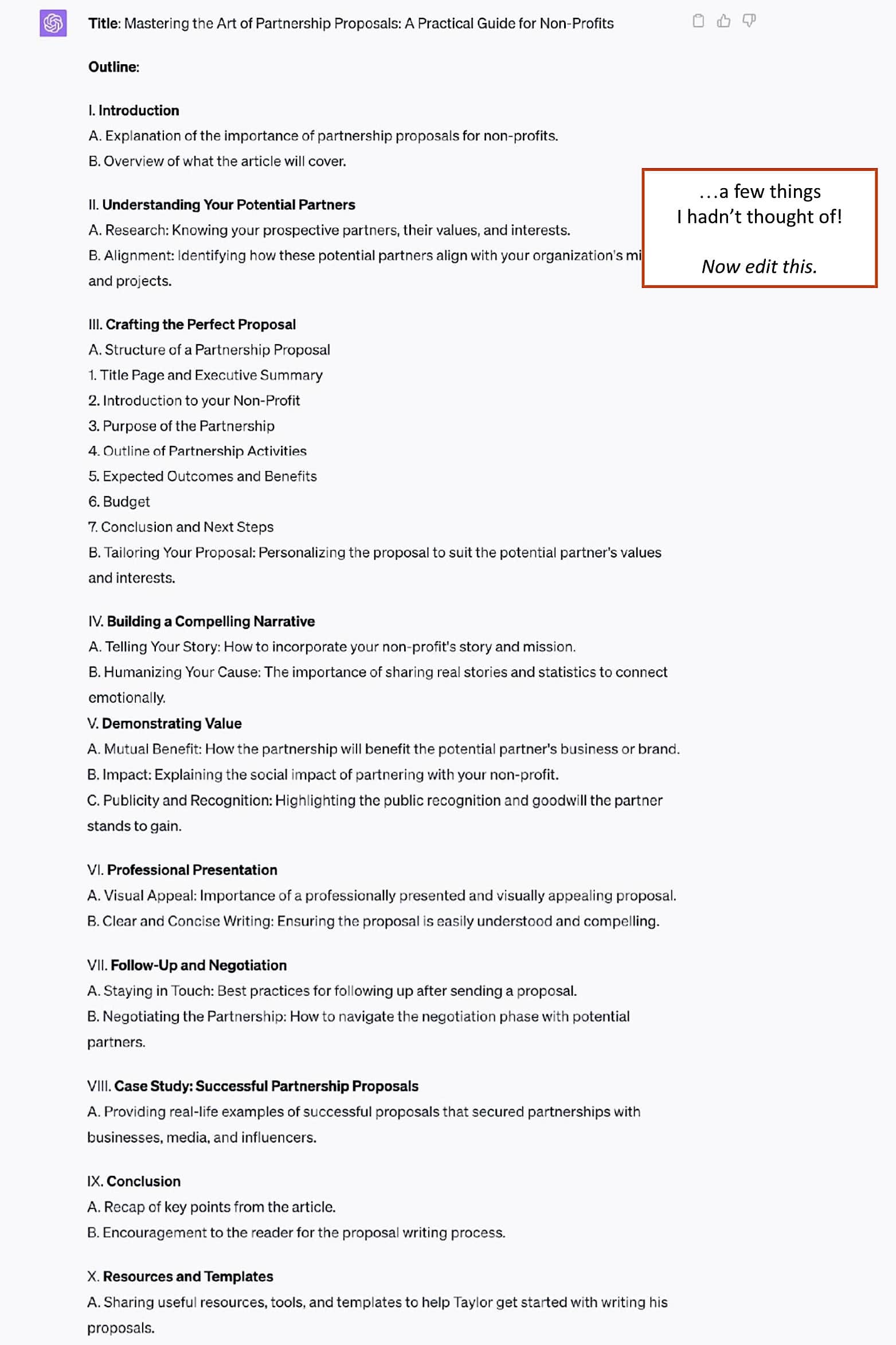
Is it a pretty solid outline? Maybe. There are some unique and clever ideas around case studies and templates, but it will require a lot more editing.
Keep in mind that AI can’t replace your expertise and knowledge of the topic. Research and incorporate additional information and details to strengthen your outline.
And, no matter how well AI tools are trained, they lack one crucial component—real-life experience. This is where your ability to create original content comes in. Blend your personal experience with your creativity, critical thinking, and problem-solving skills to build an outline that meets your audience’s expectations.
3. Create the first draft
Content writing itself is one of the most controversial but interesting stages of integrating AI into your workflow.
But first, let’s discuss why AI content marketing is often considered a bad practice. No matter what AI tool you choose, AI-generated content is written by a tool with very limited understanding of your target audience. It lacks originality and simply relies on existing web data.
That being said, how can you help the AI dish out quality content that resonates with both audiences and search engines?
- By providing the tool with in-depth information about your ICP.
- By adding a human touch through real-life experience and editorializing.
- By including unique insights with additional value.
We’re going to do each of those things now.
Let’s begin by opening our persona chat. This will guarantee that the tool continues to respond as the ICP we created earlier.
Now let’s ask ChatGPT to create a draft of the article in our style (as communicated during the preparation stage) according to our outline.
This is what our prompt looks like:
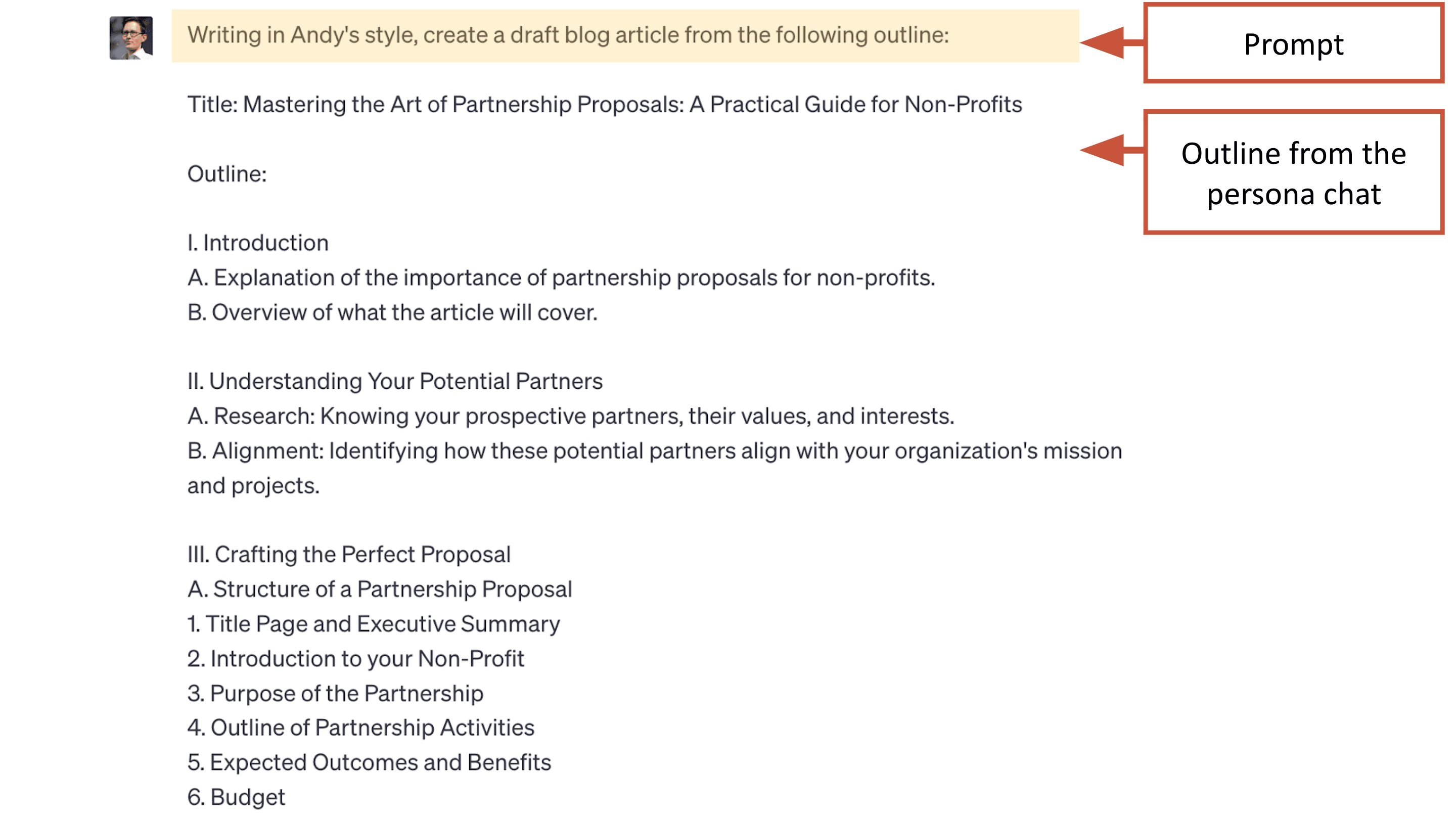
Here is the tool’s response to our request:
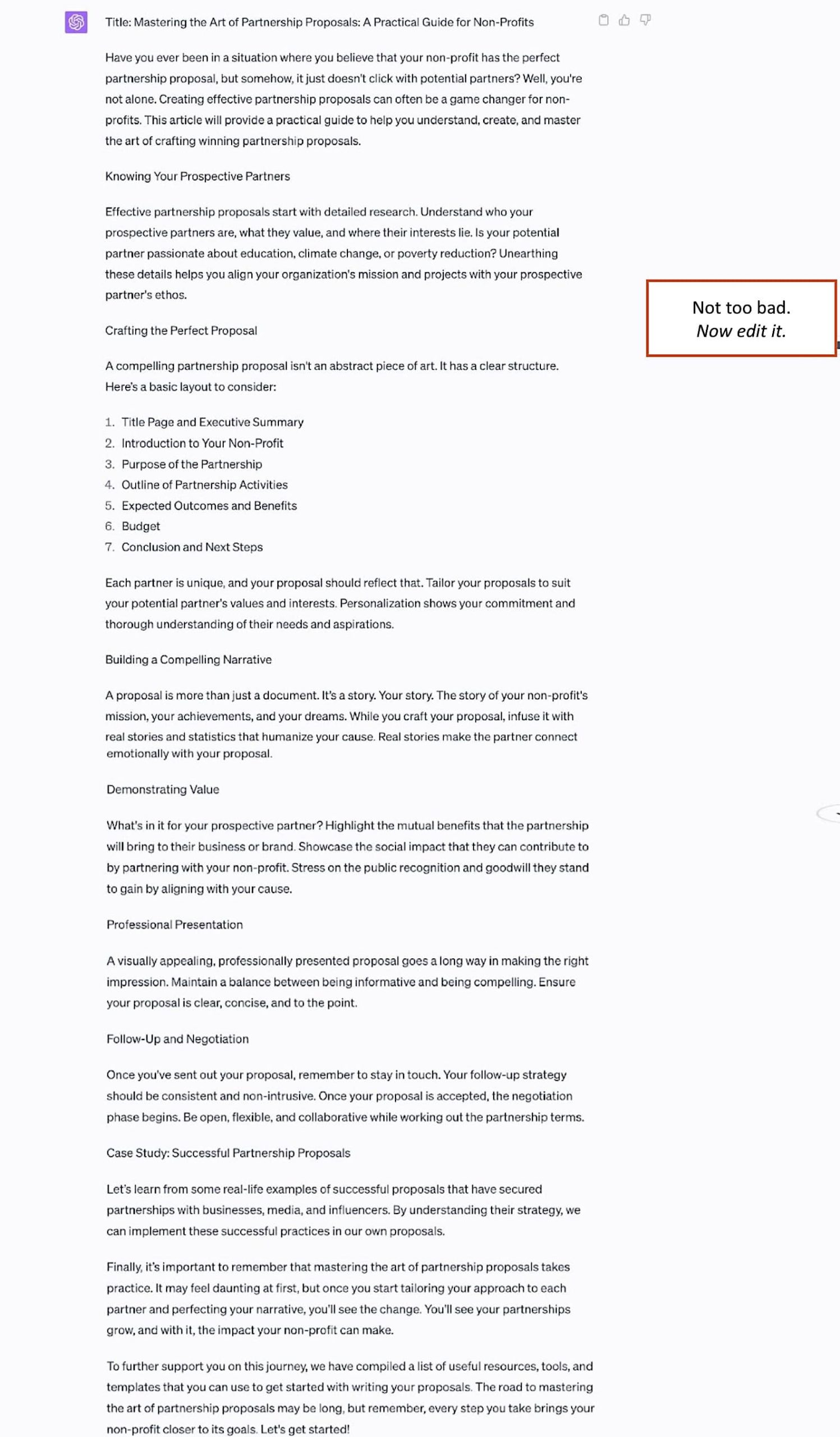
But even if this draft looks good at a glance, we still need to edit it for prominence and uniqueness. How? Use these simple tactics:
- Expand it
- Write it again, but use shorter words
- Write it again, but make it punchier and more concise
- Write it again, but add bullet points
- Write it again, but with more depth and detail
- Write it again, but in a more casual, informal tone
Enrich your content with elements other than body text, including:
- Images and embedded videos
- Contributor quotes from experts
- Specific examples
- Supportive data
- Links to related content
- Strong opinion statements
And even if you need to make all these improvements manually, you’re still saving an hour and a half or more. Looks great!
This content piece can then be refined with CRO strategies to maximize conversions.
Now, let’s move on to the next step.
4. Come up with draft headlines
Before ChatGPT can generate headlines in your tone of voice and writing style, it needs to understand the most common techniques used by your brand in previous headlines.
Now we need to follow the same process as we did when training it to learn our style of writing. But instead of full articles, let’s input a handful of our best headlines as examples. We’ll then ask the tool to summarize our style:
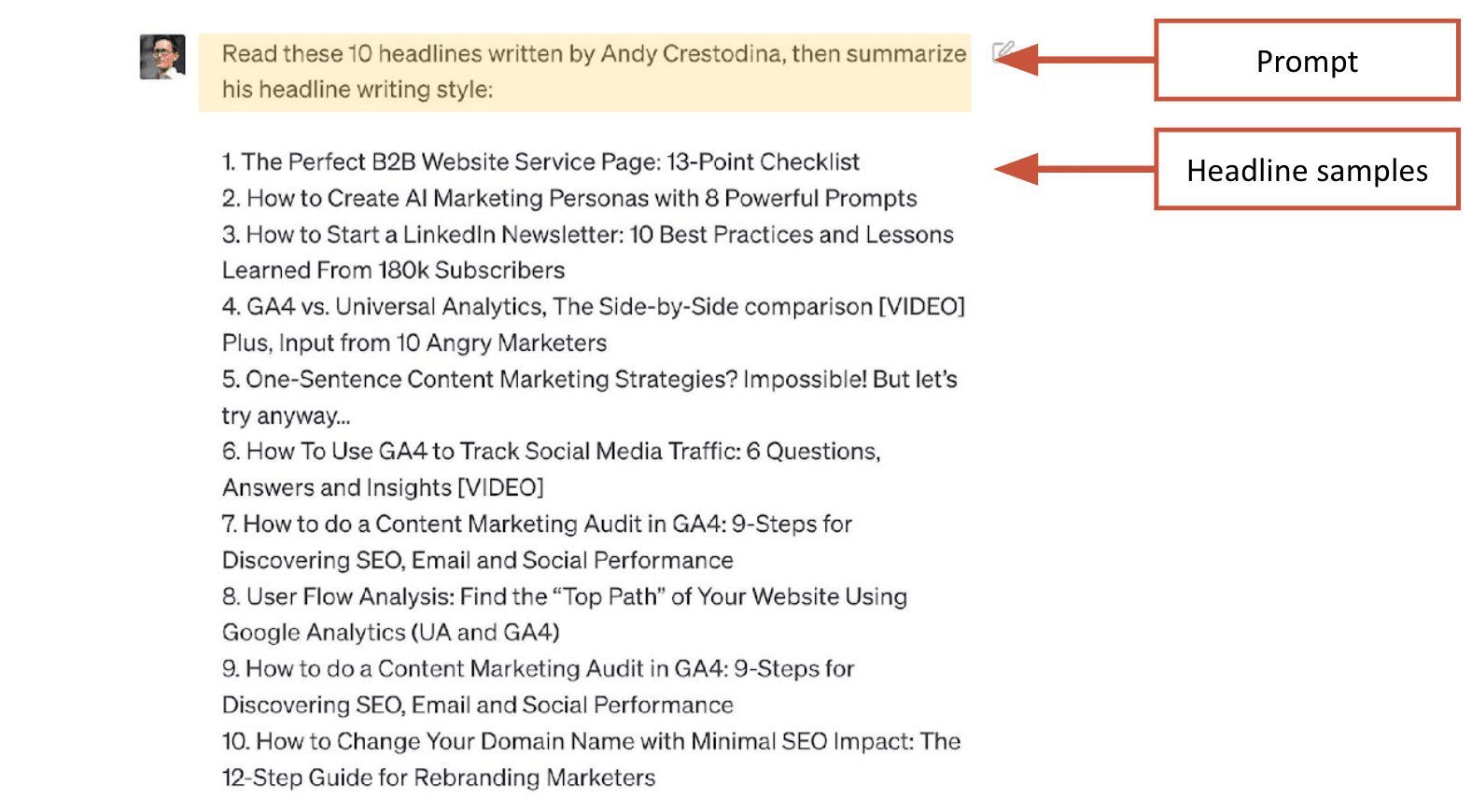
Since the tool now understands our style of headline writing, we can ask it to generate 5-10 alternative headlines for the draft of our article using our style:
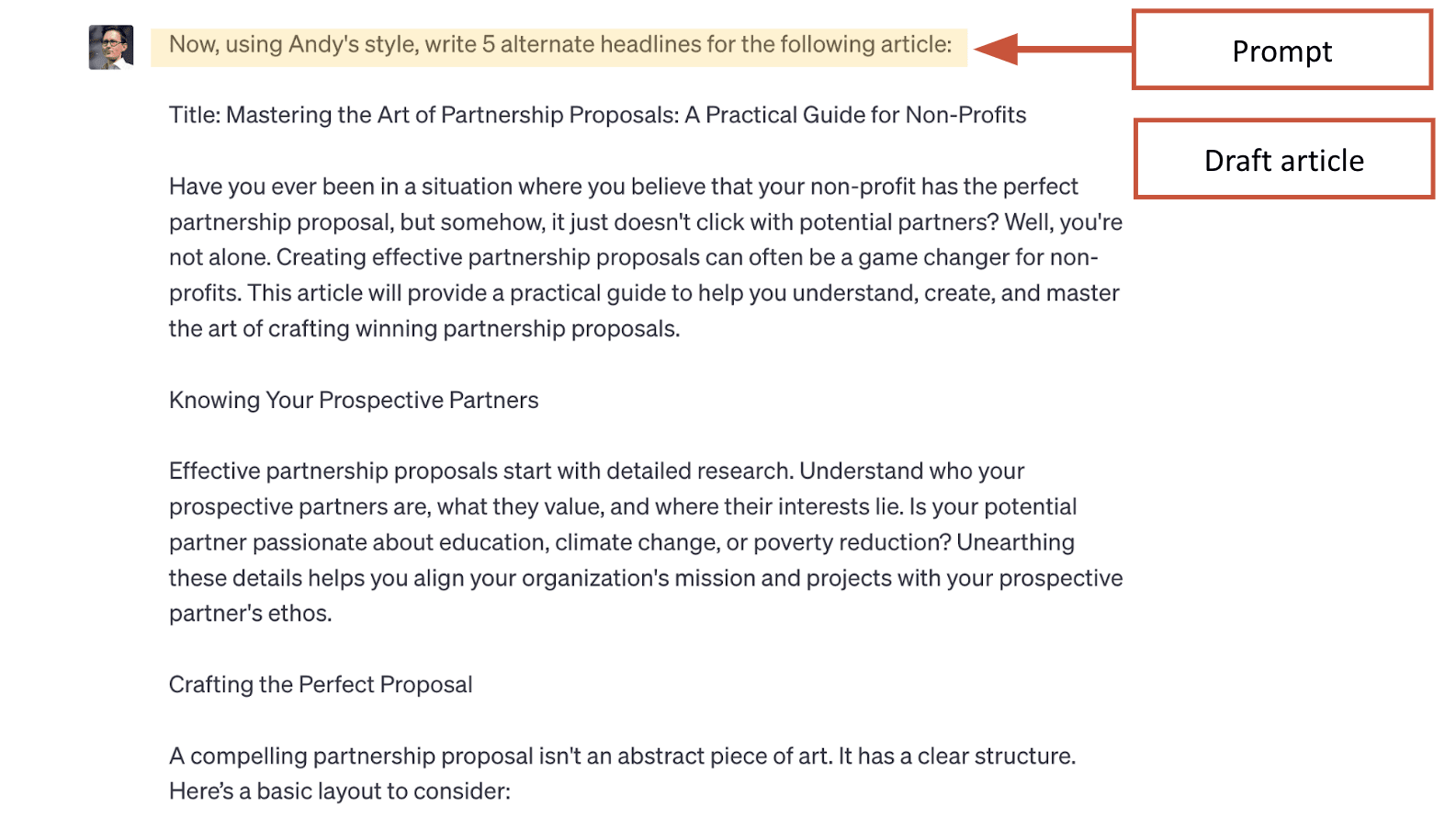
Let’s see which options the tool generates for this request:

The headline ideas it created are alright, but they are nothing special. Instead, let’s try to get it to create headlines with number words and numerals. We’ll do that by asking the tool to include numbers in its headline ideas.
Notice how the AI learns from your input.
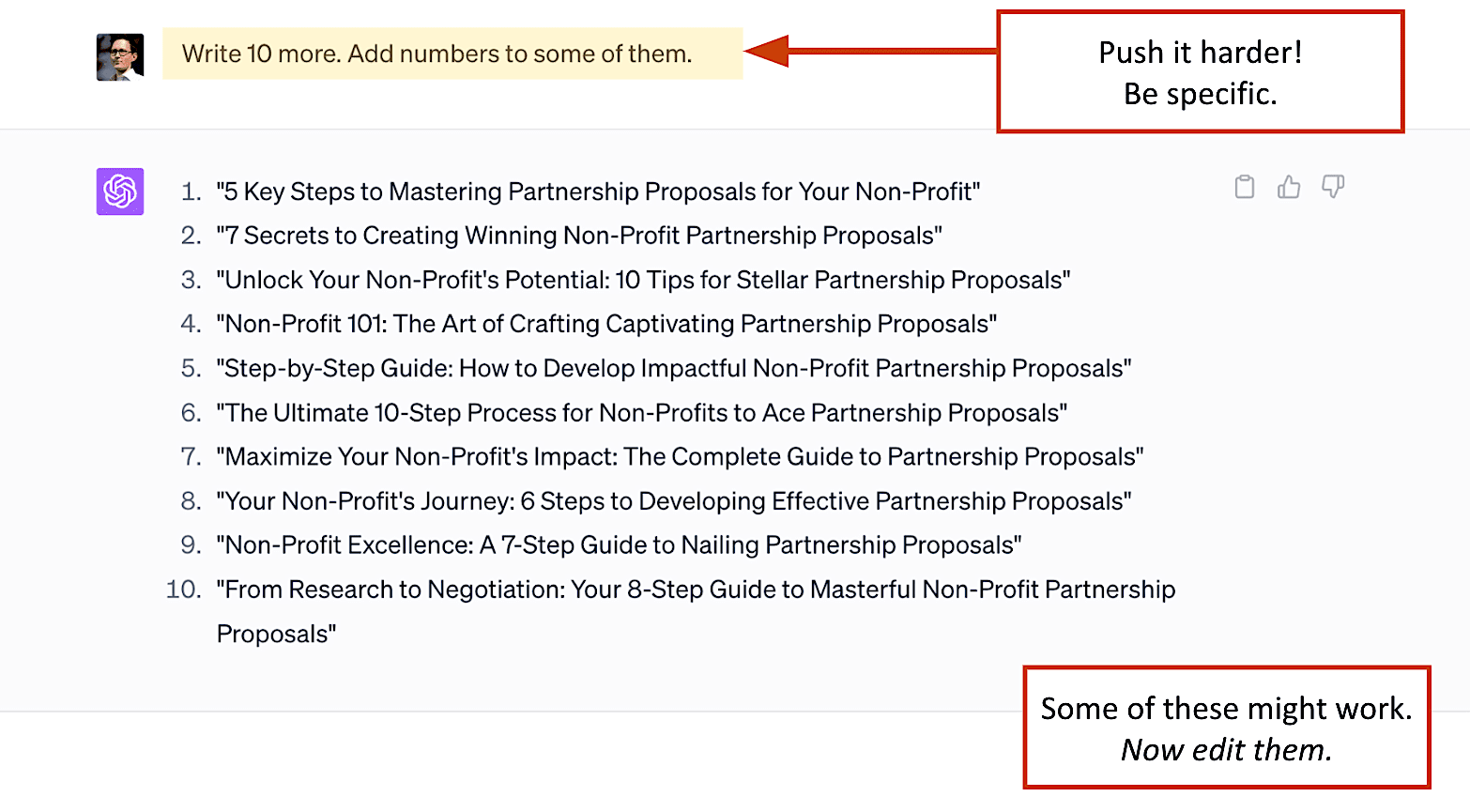
Now, its headline ideas look way better, don’t you think?
This is a great method for generating headlines, among many other content pieces. Whether you want to create a social media post, email newsletter, or metadata, you can train the tool to learn your style. Then you can ask it to generate ideas based on this. Once you have edited and improved it, the content it dishes out should be good to go.
5. Make SEO edits
There is one final way in which AI content marketing can boost your productivity and efficiency. ChatGPT, for one, can save you time and effort by suggesting SEO improvements for your existing content. This means that utilizing ChatGPT can actually increase your chances of ranking higher on SERPs.
Let’s explore the process step-by-step.
1. Find an almost-high-ranking page
Let’s say you run a company that offers social media services for non-profits. You rank #5 for the “lapsed donor letter” Good keyphrase.
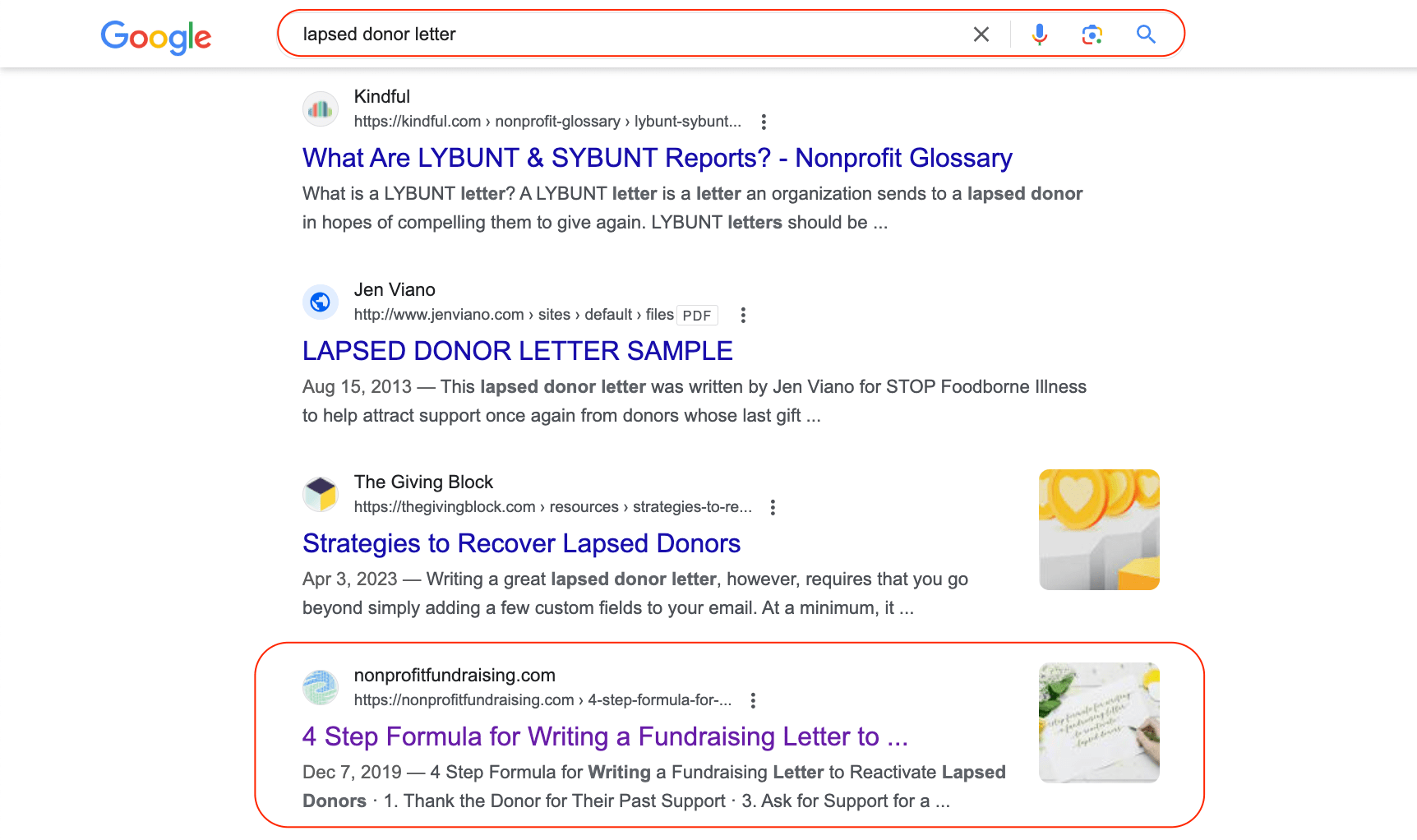
If you want that content to rank higher, can AI help? The answer is yes.
Let’s take a look at the page first to see why.
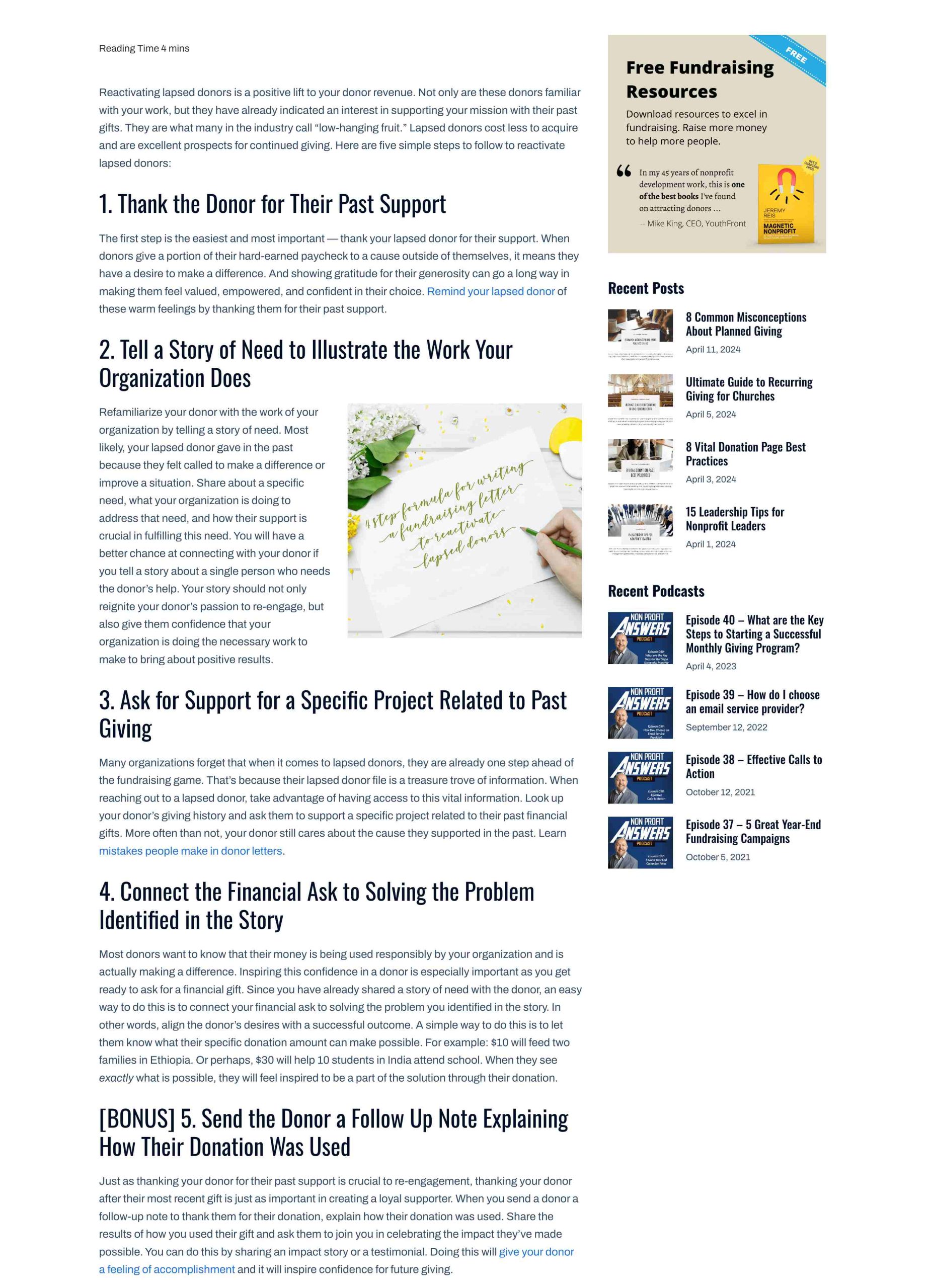
The page looks decent at first glance. It’s 900 words in total and contains five sections and one image. Let’s increase our ranking potential by including more semantically related phrases.
2. Identify semantically related phrases
One way to identify semantically related keywords is to analyze the queries in Google Suggests.
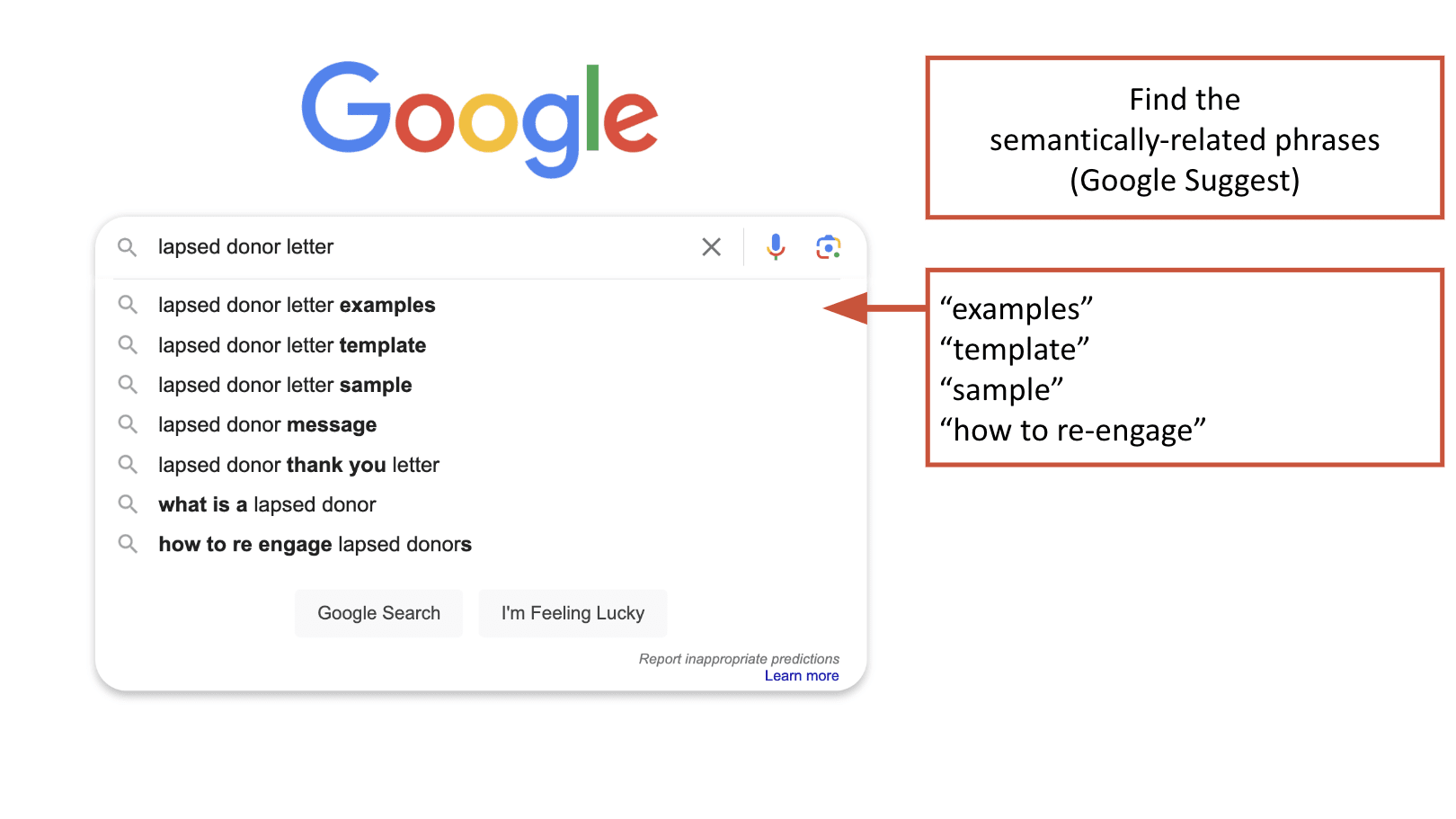
This method helped us find the following phrases for our keyword list:
- lapsed donor letter examples
- lapsed donor letter template
- how to re-engage lapsed donors
- lapsed donor letter sample
The People Also Ask For section is another useful avenue for finding keyword opportunities.
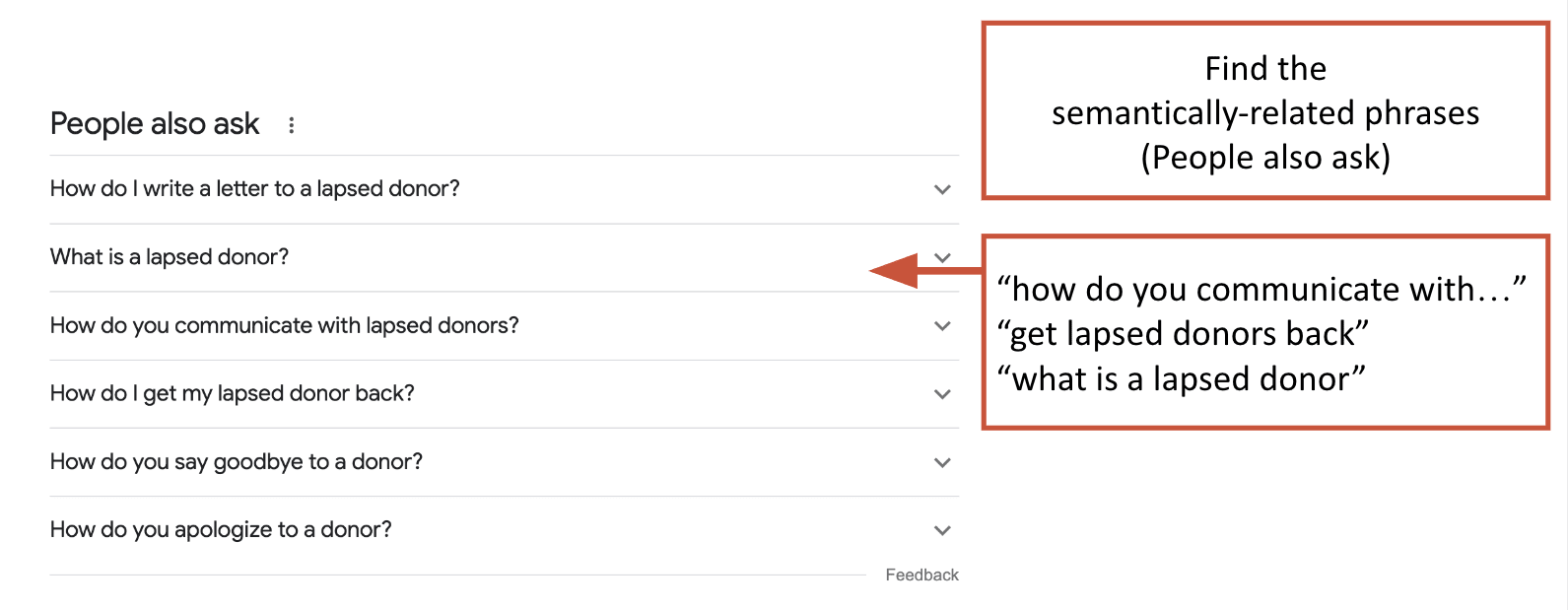
However, the most convenient way to identify and build a semantically related keyword list is to use special tools. For instance, SE Ranking’s Keyword Research Tool gives you access to downloadable keywords in seconds.
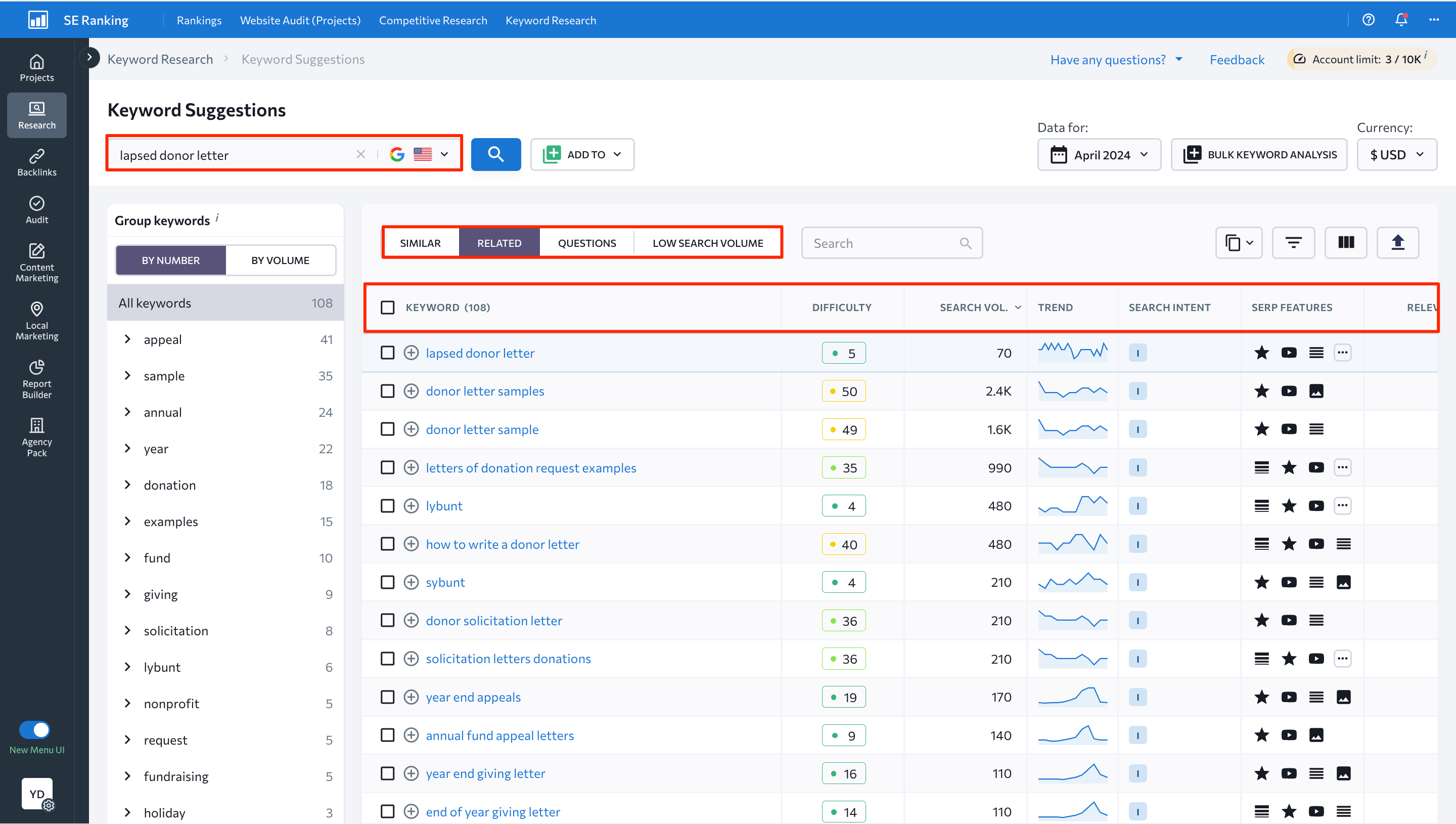
Just insert your focus keyword into the tool and go to the Keyword Ideas sections. You’ll see three separated keyword groups: Similar, Related, and Question-Based. Click the View Detailed Report option under any of these sections to see an expanded list of keywords and their corresponding keyword data, including search volume, keyword difficulty, search intent, competition, relevance, SERP features, and so on.
Refine the search by applying relevant filters, build your own keyword list, and export it either in .xlsx or .csv format.
3. Prompt the AI to write new keyphrase-focused sections
Now that you have a list of valuable keyword opportunities, you can ask ChatGPT to incorporate them into your existing content. In particular, consider asking the tool to write an additional blog post section featuring your newly detected keywords:
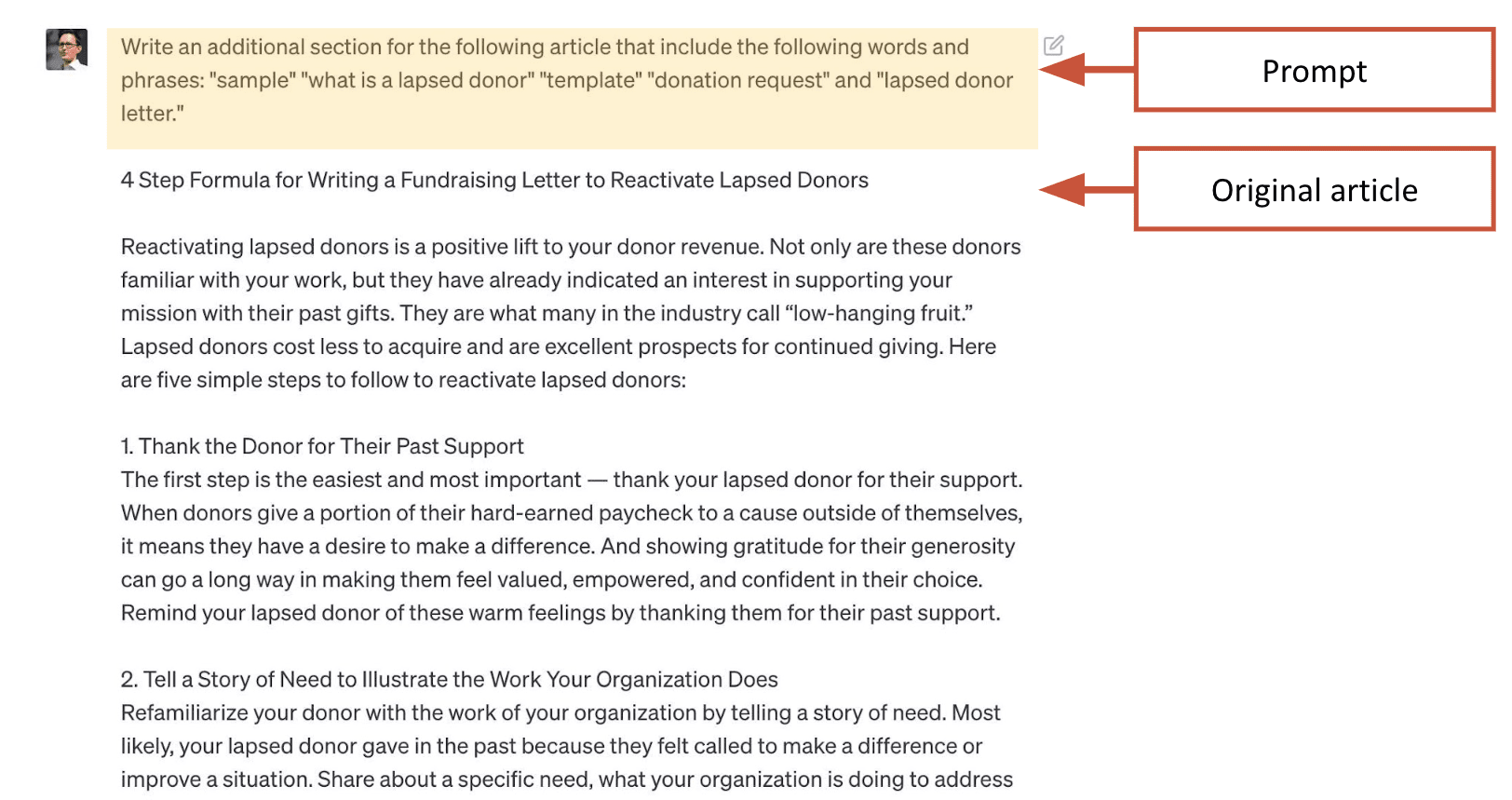
Here is an example of what ChatGPT will generate with the filters applied:
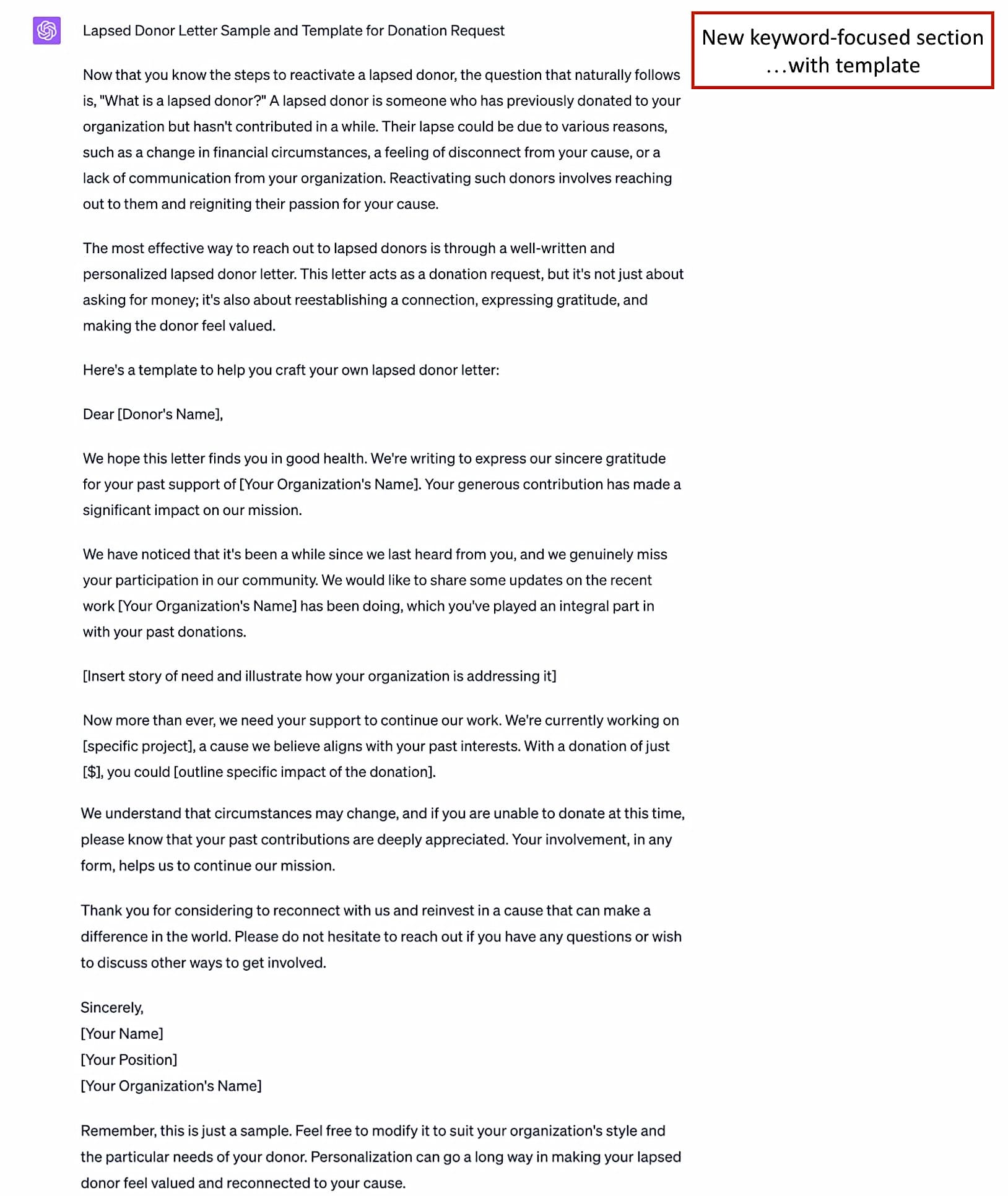
4. Add a content piece to the article
Make a habit of editing the content piece offered by the tool to ensure it reflects your unique brand voice and perspective. Conduct additional research to identify your competitors’ content gaps and fill them with unique and valuable information.
The result should be a webpage enriched with informative content distinct to your company. By incorporating semantically related keywords, you’ll boost your chances of acquiring high search rankings.
Bonus tip: Use AI to audit and revise a webpage
Let’s look at another helpful AI content strategy: content audits and high-impact webpage revisions.
Let’s begin by pretending you run a company that helps launch commercial satellites. Your target audience is commercial satellite operators. Here’s what the homepage looks like:
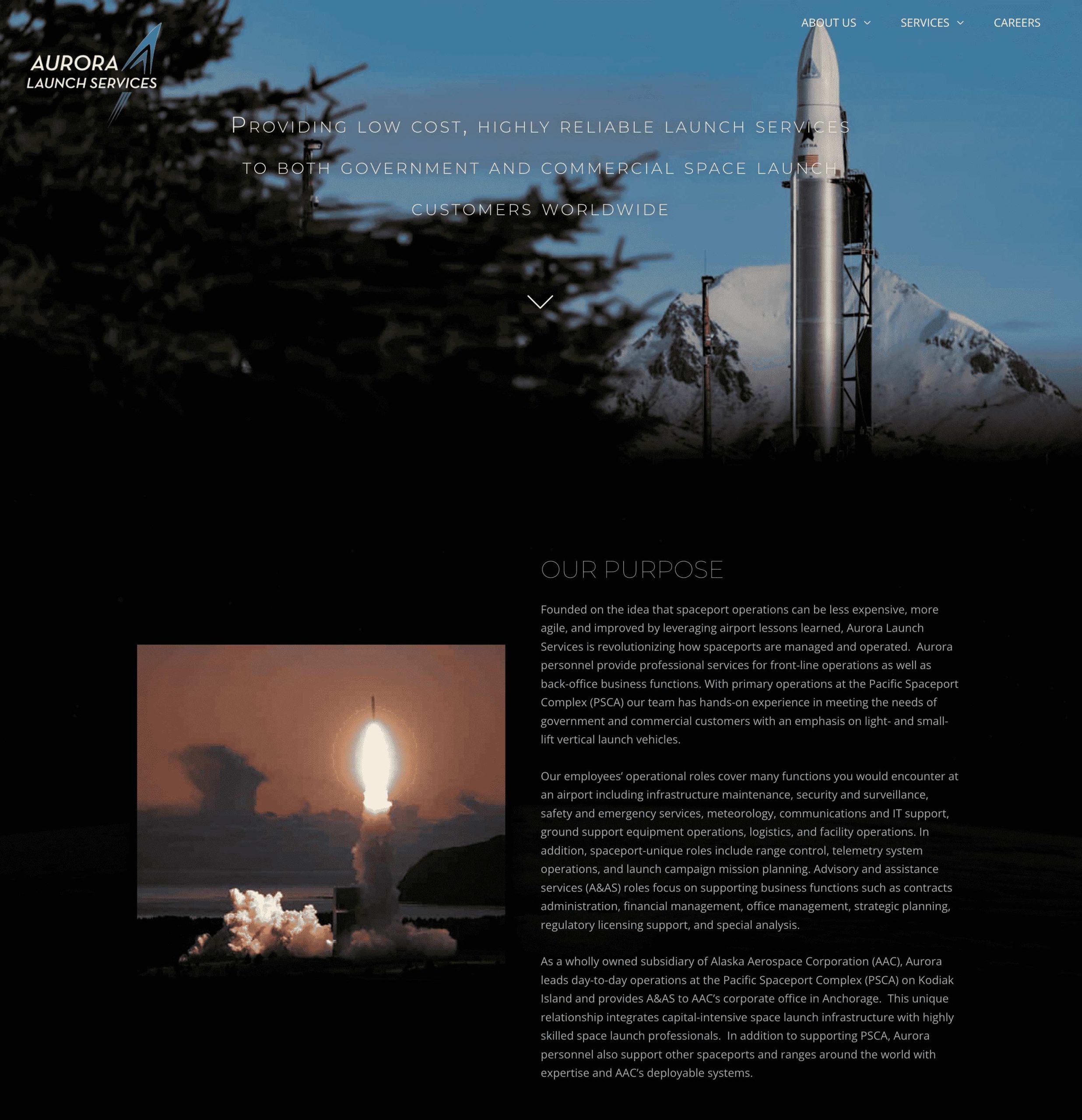
The page looks poorly constructed. With only 325 words in small font, its content reads like a plain wall of text. What’s more, it lacks depth and engagement.
Text structure-wise, the page only has one main heading, a subheading, and three short paragraphs. Unsurprisingly, it ranks at #28 on SERPs.
Can AI help you improve this webpage’s rankings? Yes, it can!
Just follow two simple steps:
1. Build a buyer persona.
Here’s the prompt that we’ll use for this purpose:
Build me a persona of a commercial satellite operator who works for a global telecommunications company. List the roles, goals, challenges, pain points, and decision criteria for selecting a spaceship launch services company.
Again, don’t hedge your bets on the truth of the AI’s initial response. In the current example, research reveals that the AI’s pre-written decision criteria lack geo-political considerations, ride-share opportunities as well as insurance and risk management. See the decision criteria input below for selecting a launch services company:
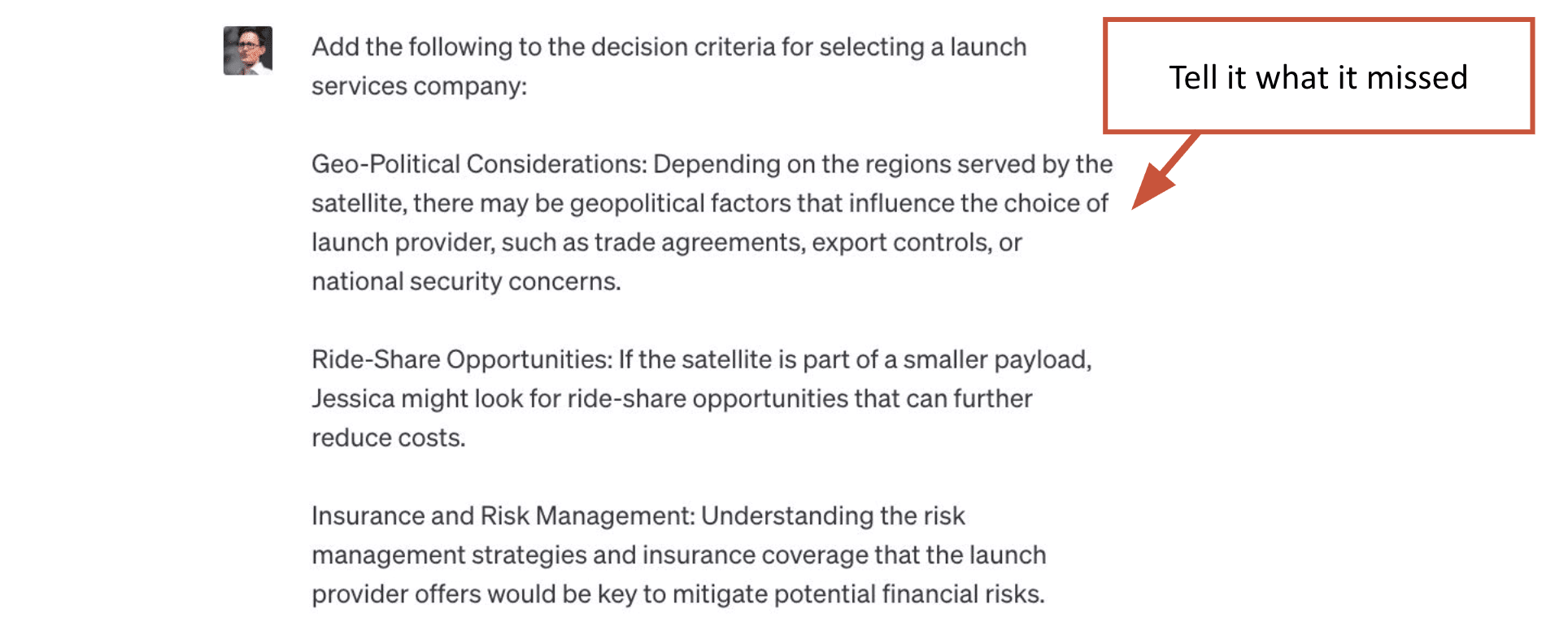
2. Ask ChatGPT to review webpage content. Tell the tool to analyze how this content aligns or doesn’t align with the ICP’s needs.
See the following prompt in the screenshot below:
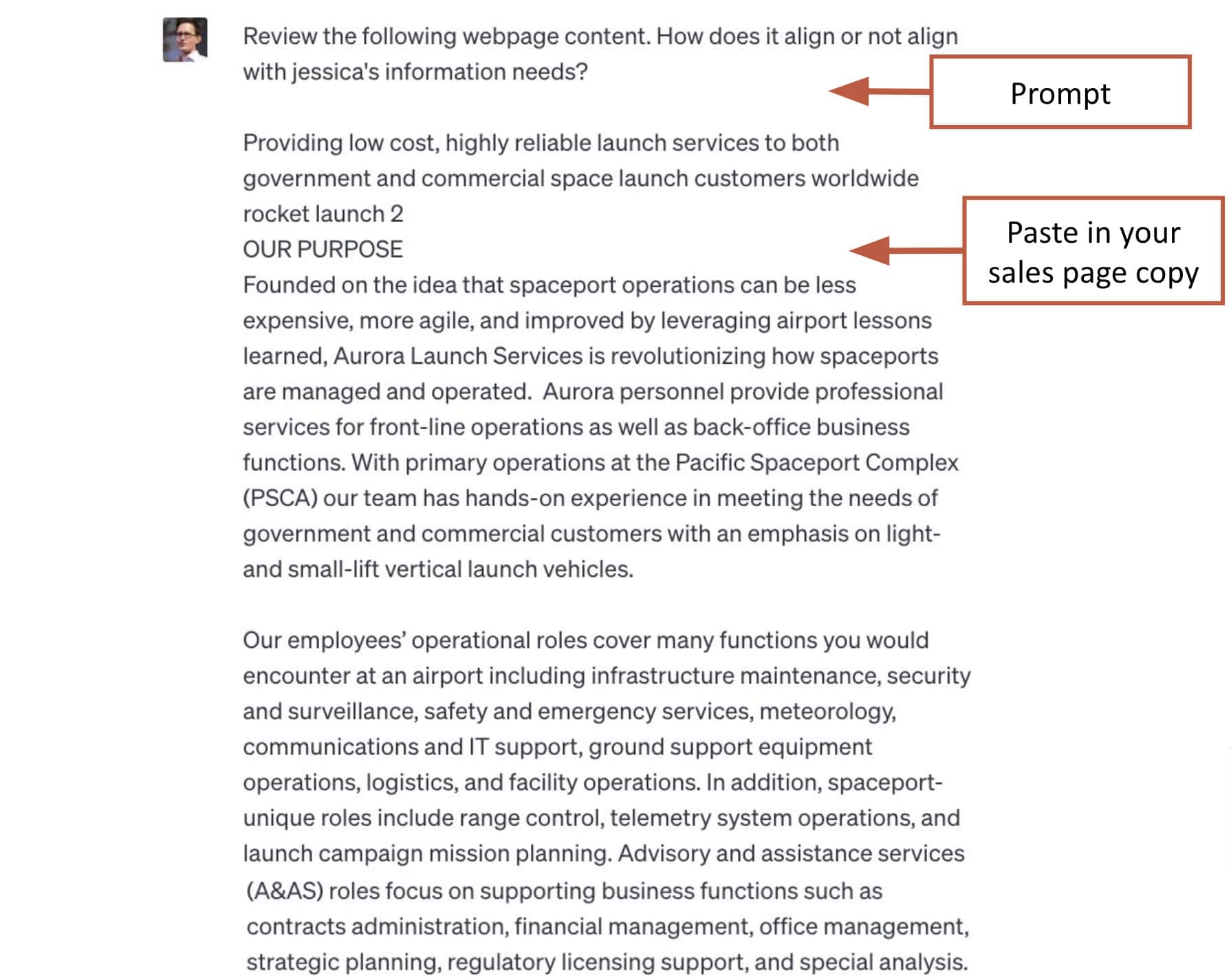
Now, let’s take a look at the AI response here:
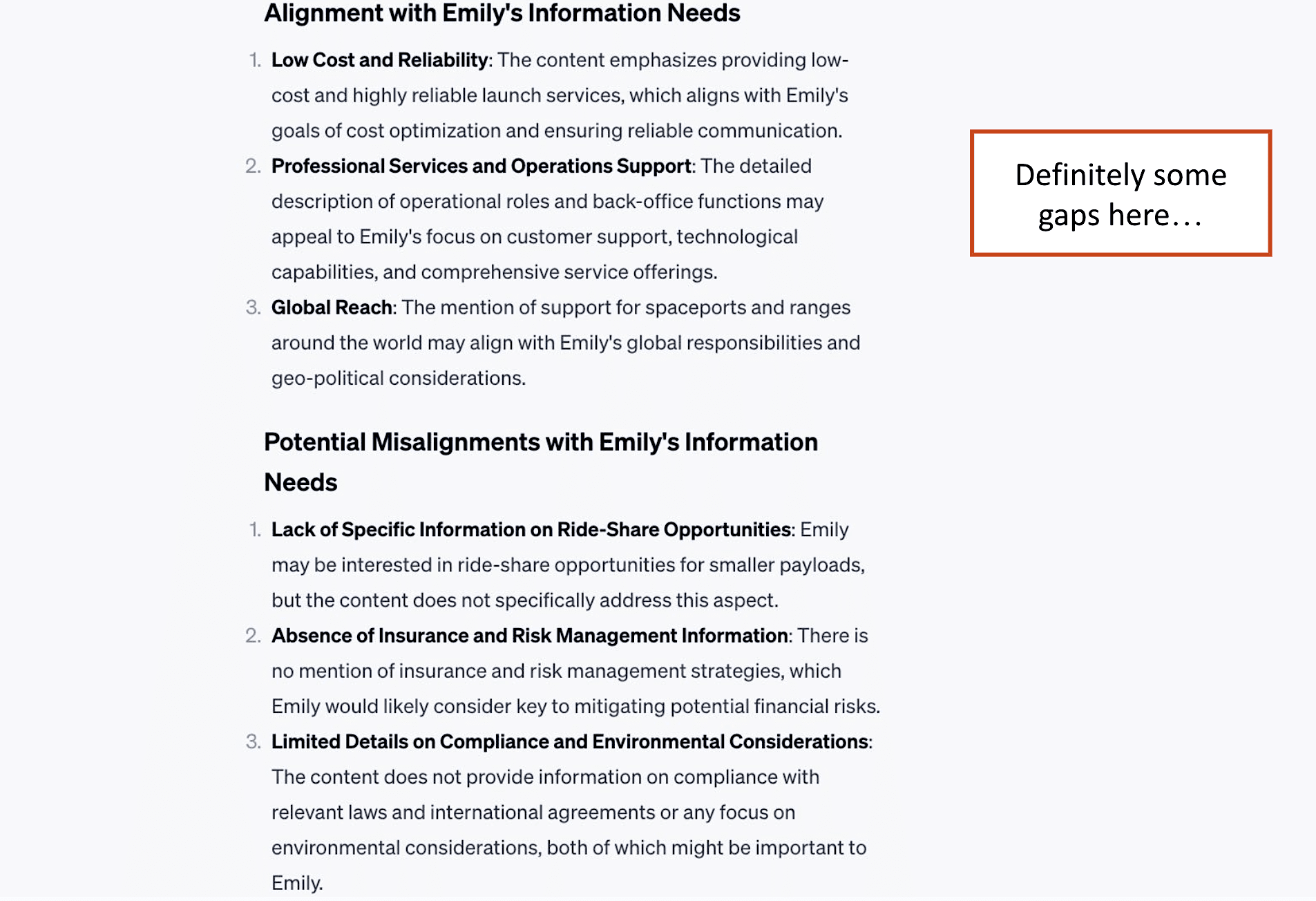
This technique’s greatest value stems from its uncanny ability to help you identify gaps otherwise invisible to the human eye. While our brains tend to focus on what’s presented and accept it as the complete picture, AI can analyze your ICP and existing content to perform a persona-driven “gap analysis” for commercial intent.
The same technique can be applied to any website, not just yours. For example, you could input a competitor’s content piece into the AI tool and ask it to compare their piece to yours in terms of meeting your ICP’s informational needs:
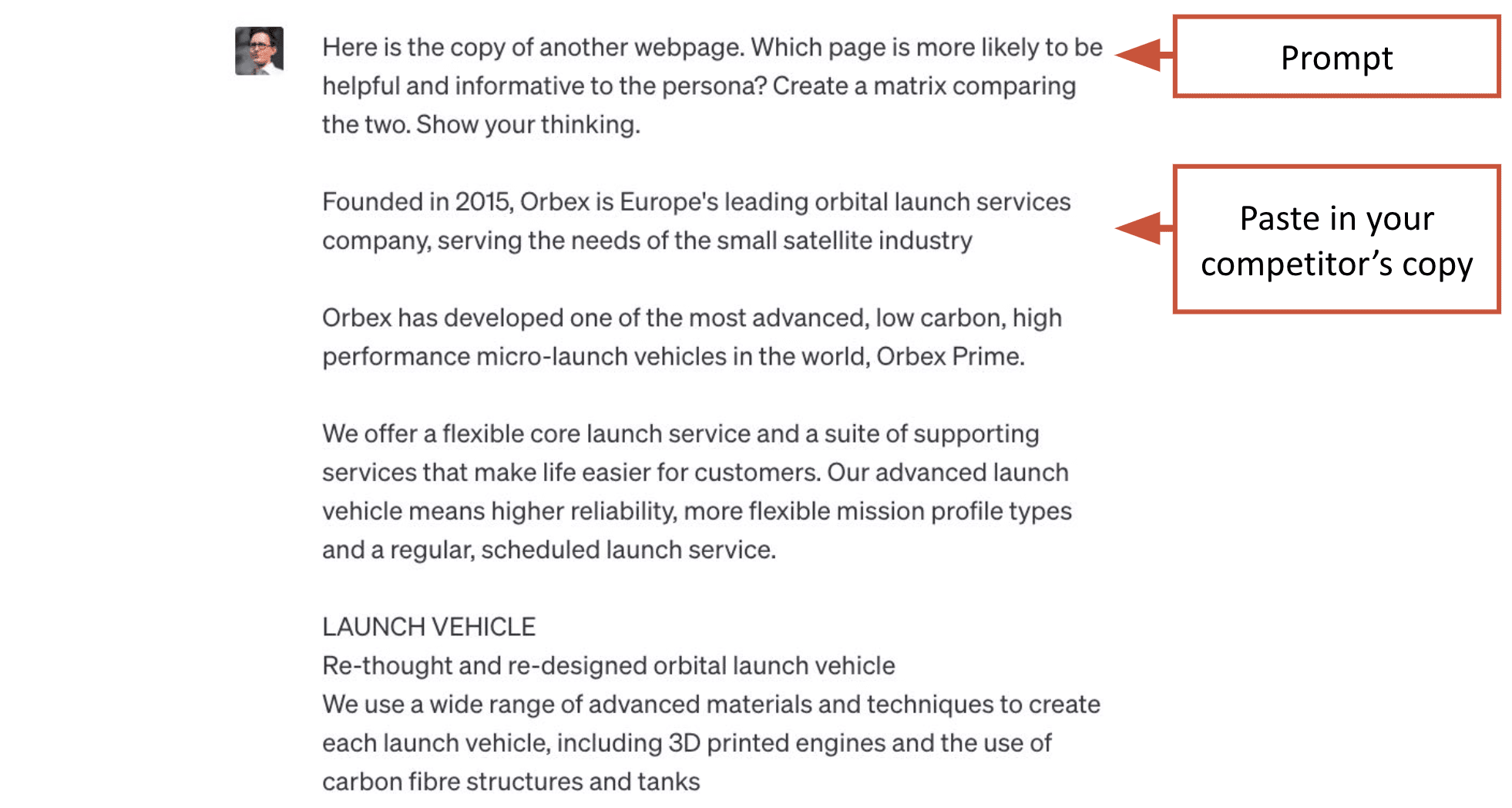
This is the result:
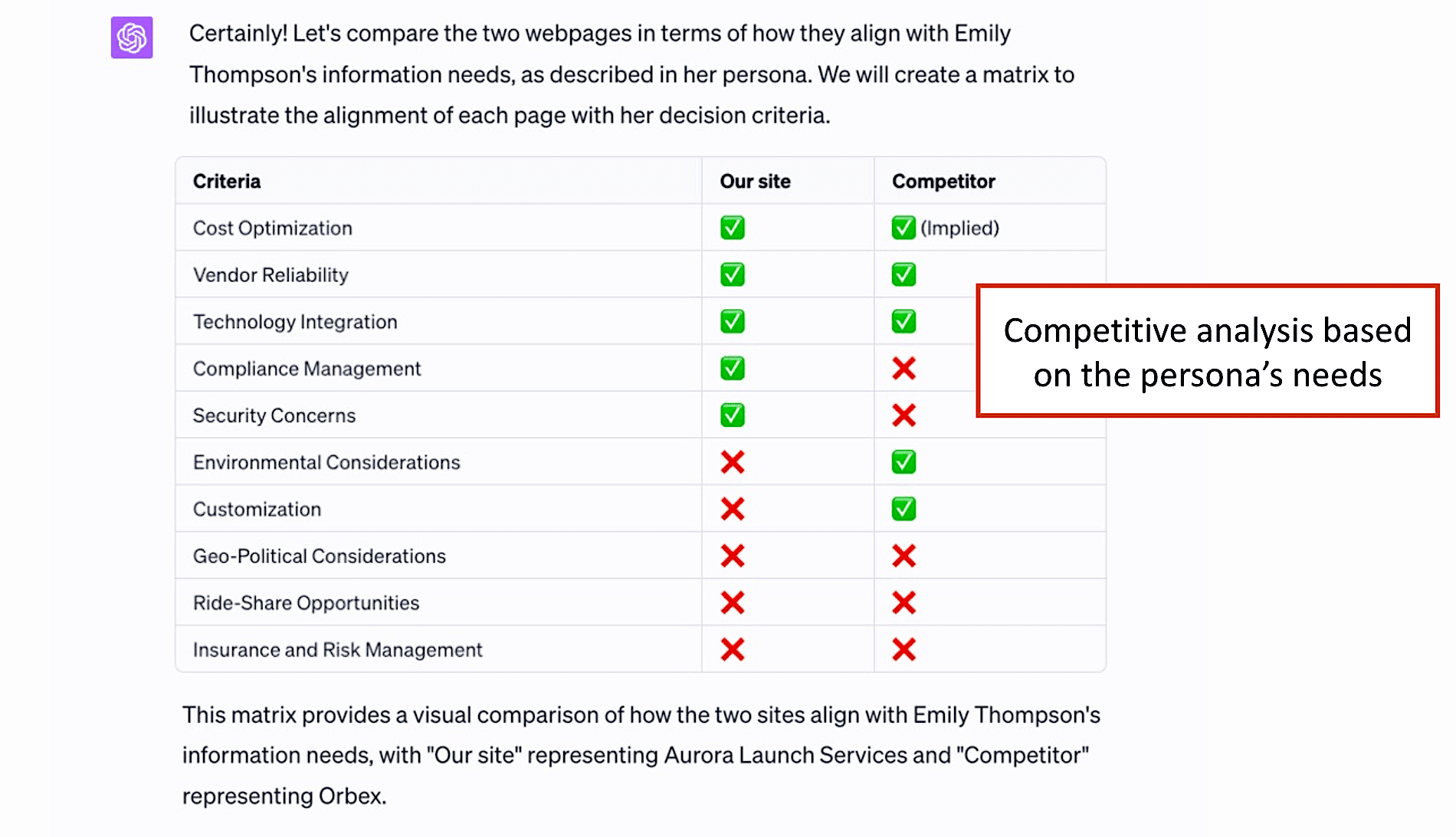
You can even ask for a bar chart to see content gaps in a more visually appealing way:
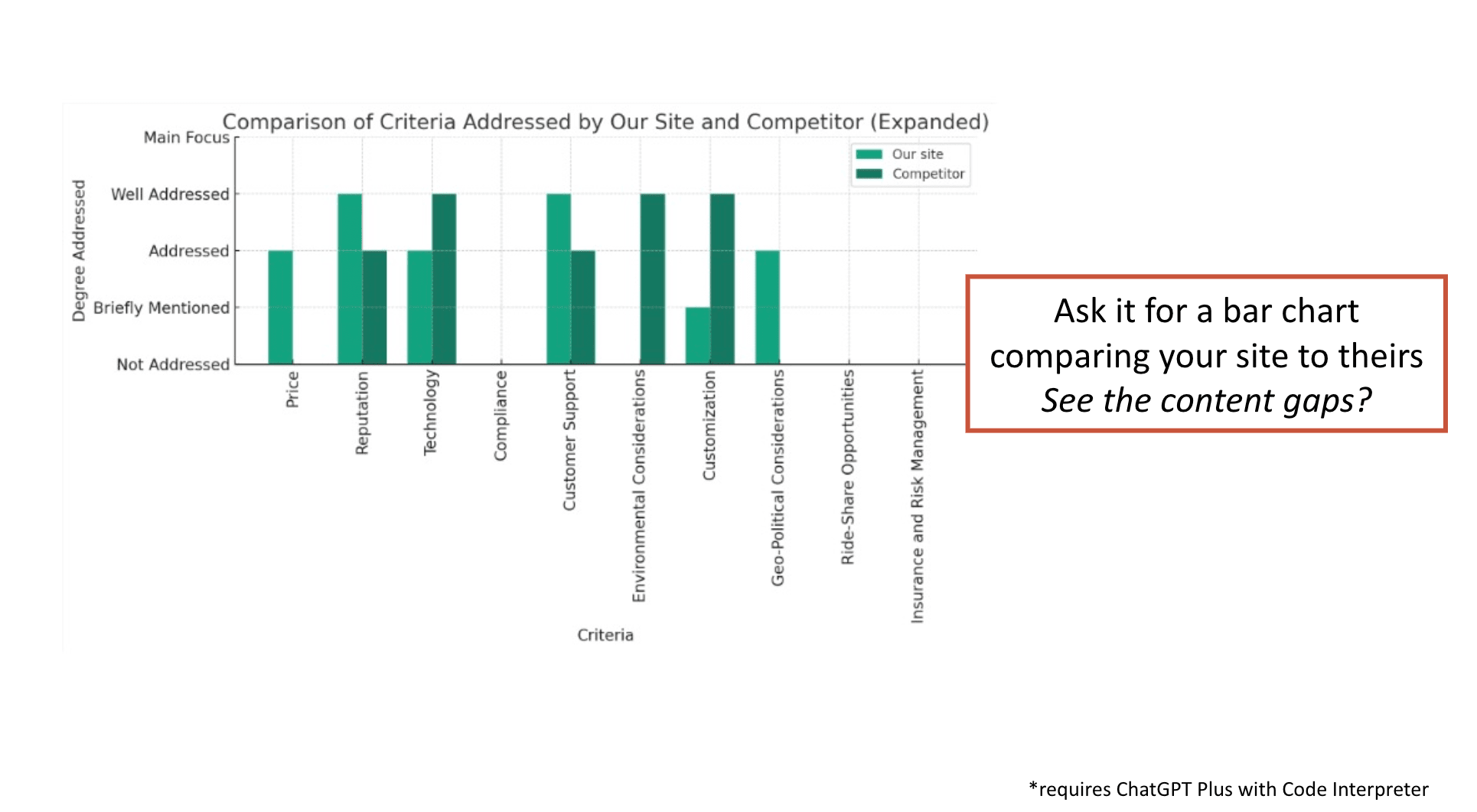
Looks impressive, right?
Well, there is another technique worth experimenting with. It can help you gain insights into the effectiveness of incorporating different keyword categories on your page and how well your content topics address your ICP’s informational needs.
Here’s how to do it.
1. After collecting your semantically related keywords, copy and paste them into a prompt and ask the tool to categorize them.
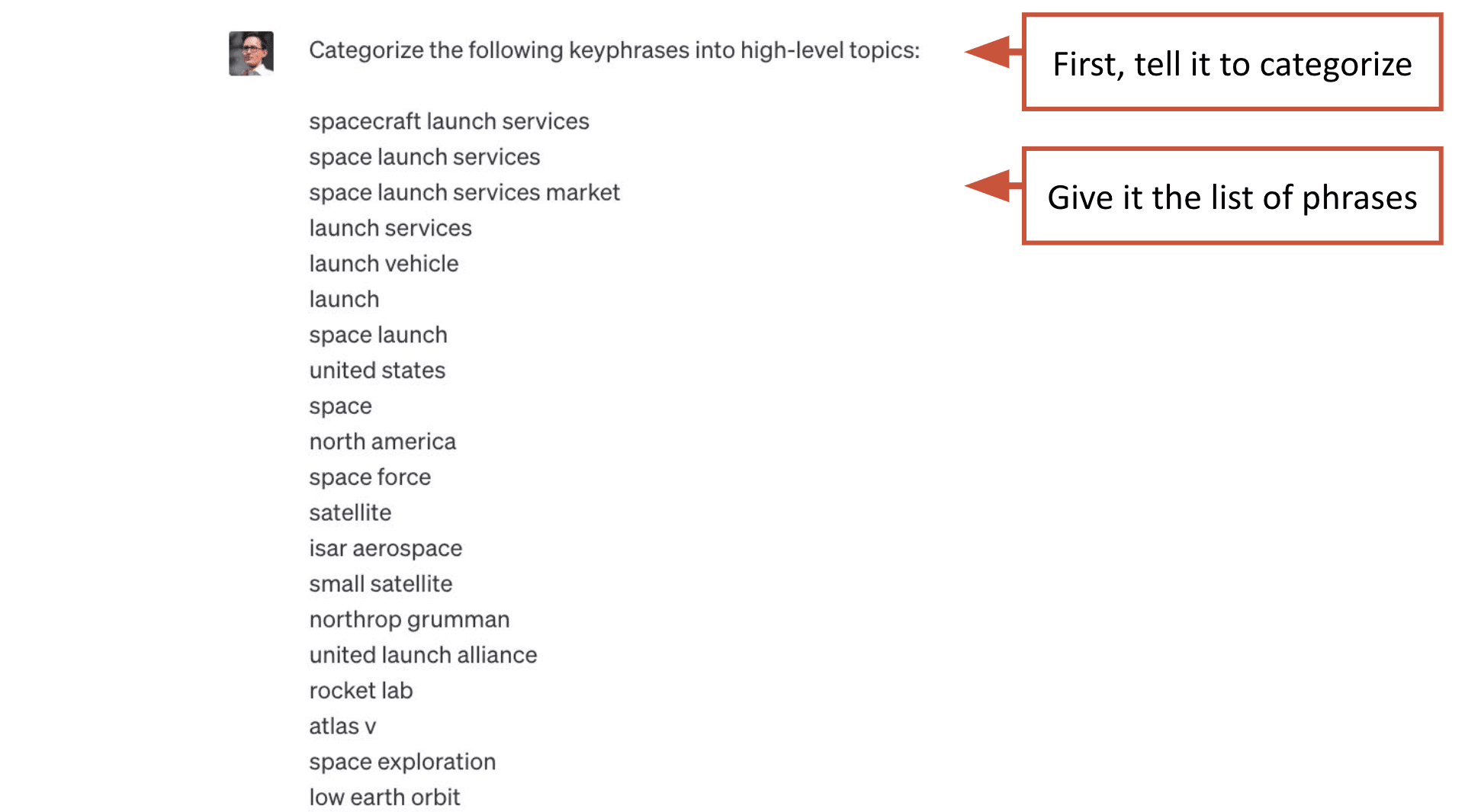
2. Instruct the tool to create a three-column table. The first column will focus on the key informational needs of your ICP. In the second column, ask the AI to add a new metric, called Conversion Clarity. This score will assess the page’s ability to inform and persuade. The third column will feature another new metric, entitled Keyword Relevance. This will demonstrate the effectiveness of your page in including keywords from those categories.
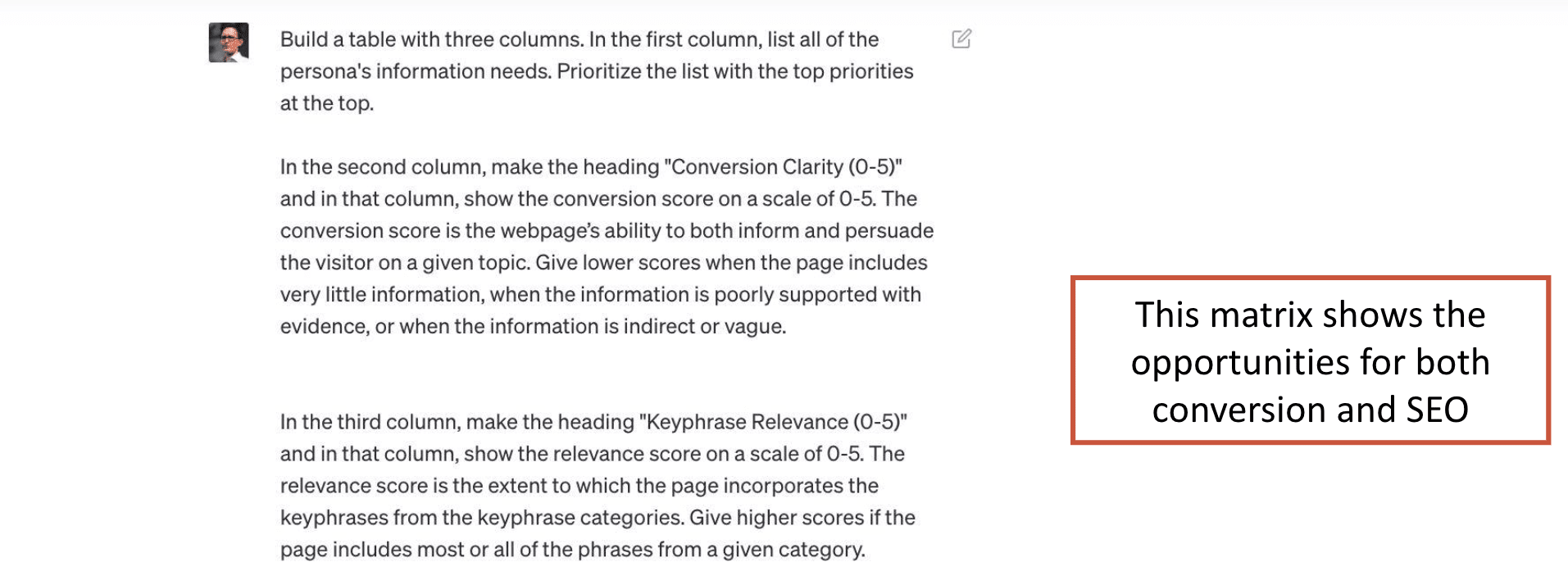
The tool will then provide a comprehensive table based on the scoring system you asked the tool to develop.
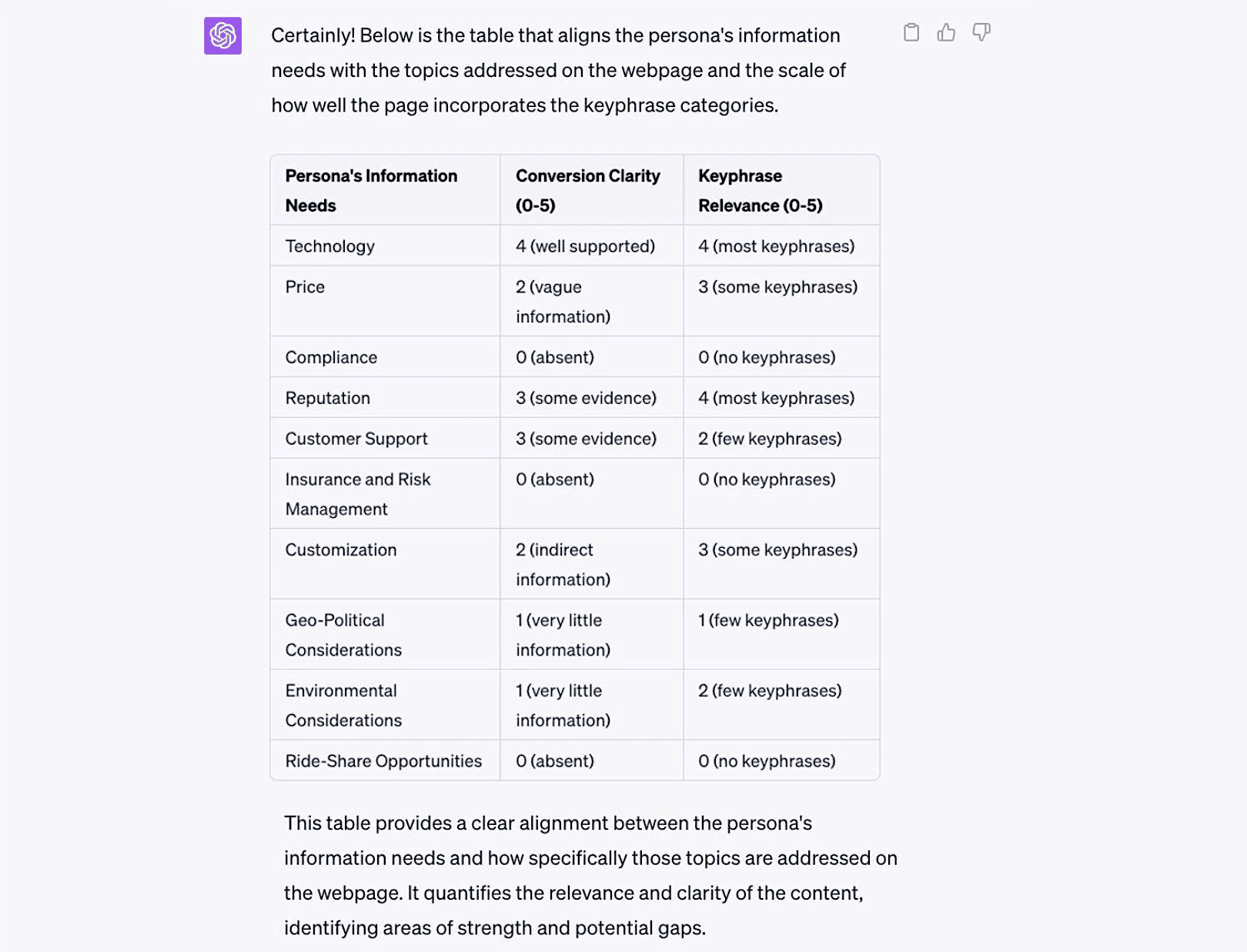
No matter how much experience you have in search and conversion optimization, it’s rare to see a chart with such actionable data and insights. With AI’s help, we made something with incredible value!
Here are some more prompts to play around with after receiving your content outline:
1. Using the outline above, write a revision to the webpage that gets a 5 across the board.
2. Expand on the copy, adding detail and short paragraphs. Use persuasive copywriting techniques. The page’s goal is to rank well and convert visitors into leads for our services.
3. You are Andy Crestodina, author of Content Chemistry [you have taken Joanna Wiebe’s copywriting course/you have read “Copywriting Secrets” by Jim Edwards, etc]. Rewrite the draft based on the outline, using the keyphrases and SEO best practices while using persuasion and conversion copywriting techniques.
Create the perfect outcome by reducing irrelevant information and expanding on top insights. Go for it!
Conclusion
We’re now surrounded by incredible AI potential. Ignoring it would be a missed opportunity.
However, here’s a key AI content marketing tip I want you to keep in mind: the AI’s first response is rarely perfect. Rephrase your prompts, edit responses, and ask for more examples. Incorporate your unique expertise and real-life experience. By doing this, you can generate high-quality content pieces and easily achieve a 20% (or more) productivity boost!

